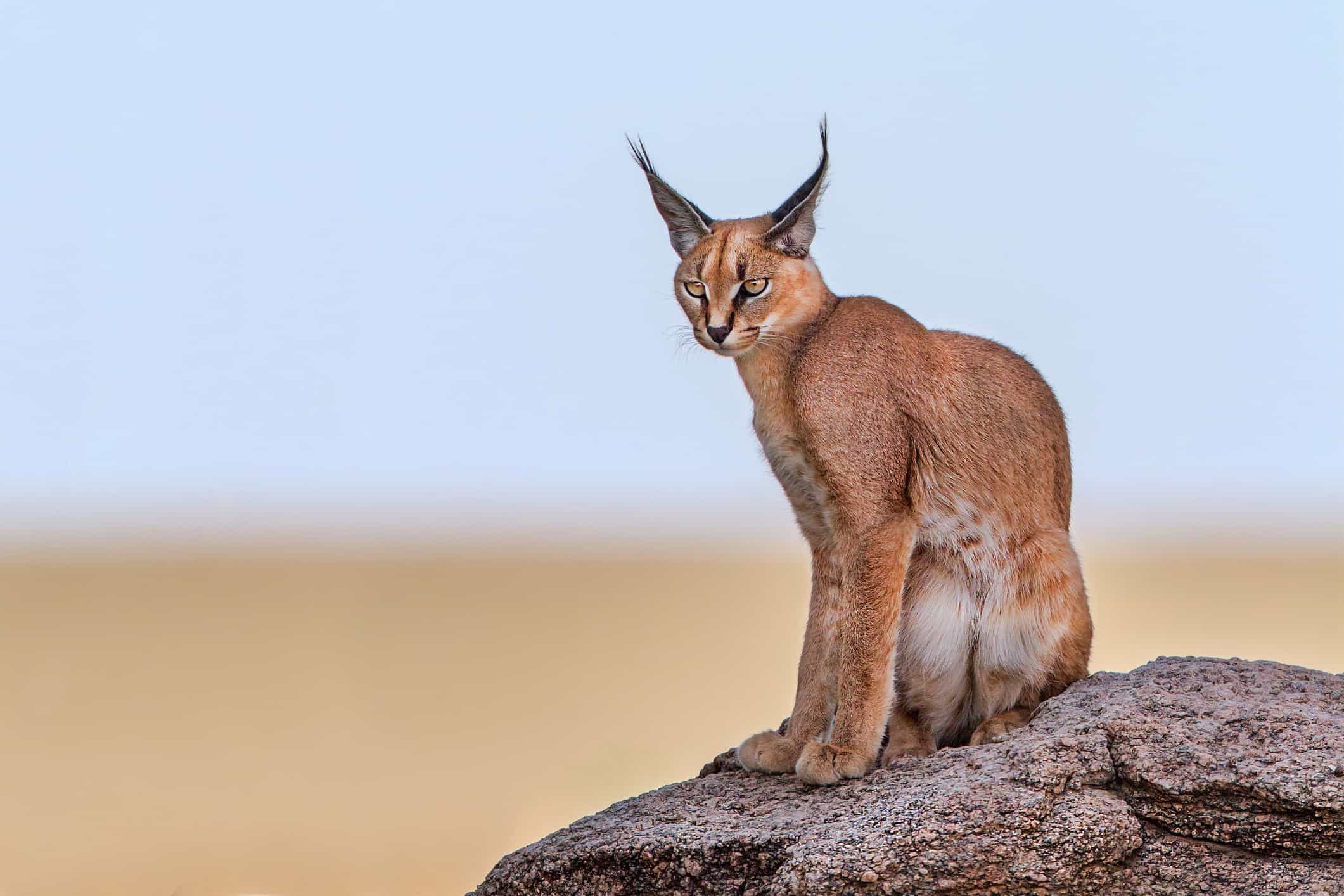History is filled with some of the most amazing animals. Some of those very animals still live today – while others are long gone. However, perhaps nothing has been more romanticized in world history than predatory cats. In Ancient Greece and Egypt, big and small cats of all types were a consistent part of the culture.
Some were used in Gladiator battles with humans as well as other animals. Meanwhile, others were worshipped like Gods and humans made them part of everyday life. However, big cats were around well before humans arrived. Yet we often misinterpret what a “cat” is versus what can appear as one.
This list will help set the record straight about some of the greatest predatory cats in history while also going over some you’ve never seen before. The list will be comprised of extinct cats as well as those around in the present day. We will also be including hybrids due to the need for people to know more about them.
We hope you enjoy the list and learn something new along the way!
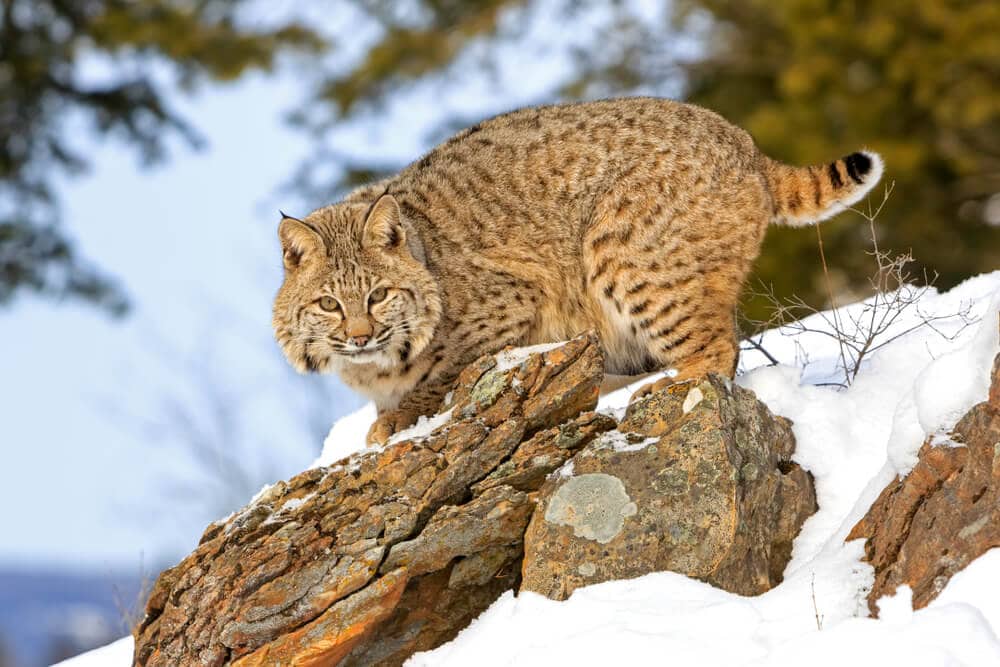
40. Bobcat (Lynx rufus)
- Current ICUN Status: Least Concerned
- Typical Location(s): North America
- Diet: Insects, Deer, Chicken, Geese, Rodents
Bobcats are incredible animals and a species that comes from the Lynx family of cats. Bobcats are normally located in North America and have been a massive part of the ecosystem for hundreds of years. The Lynx family of cats is abundant across both American continents, but the Bobcat is only native to the Northern end. They can also be tough to predict as their diet will always depend on their location.
The average Bobcat will eat things like insects, small rodents, and other small mammals. However, if their habitat includes other types of animals, they’ll evolve to hunt the bigger animals. This is why Bobcats are also known for taking down chickens, geese, and even multiple deer. Bobcats can be quite territorial, and it’s one of the reasons they attack bigger animals, including humans. Though it is rare for a Bobcat to go after humans, mothers will attack to protect their young.
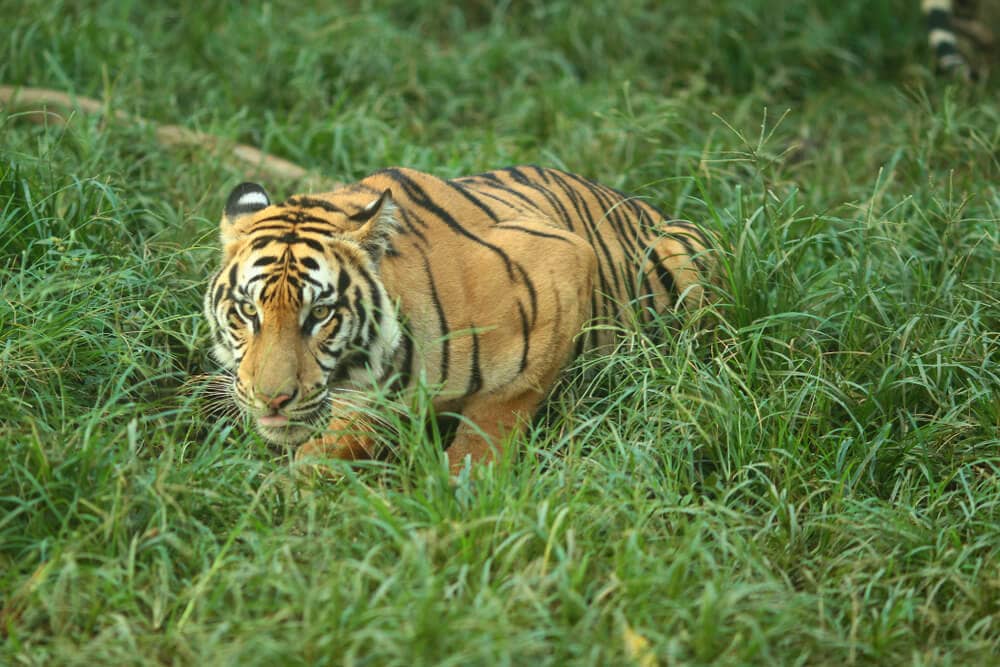
39. Javan Tiger (Panthera tigris sondaica)
- Current ICUN Status: Extinct
- Typical Location(s): Sunda Islands, Indonesia
- Diet: Anything they felt like
The Javan Tiger was one of the top predatory cats of its time, so much so that humans were afraid that they’d eventually take out everyone present if they did not go for them first. This led to the move to hunt the tigers for many years. This was a huge help for big game hunters or poachers, who would kill the tigers and sell their fur for cold hard cash. It is one of the few tiger species to have actually managed to live over 10,000 years in the same area.
Located in the Sunda Islands and eventually Indonesia specifically, they remained here for thousands of years before they were hunted to extinction. The Javan was incredibly powerful and fast for its size. Humans wanted the land these Tigers called home, so Tigers naturally fought this habitat loss and eventually had humans for dinner some nights. The problem is that man had guns and the Javan Tiger was no match for that.
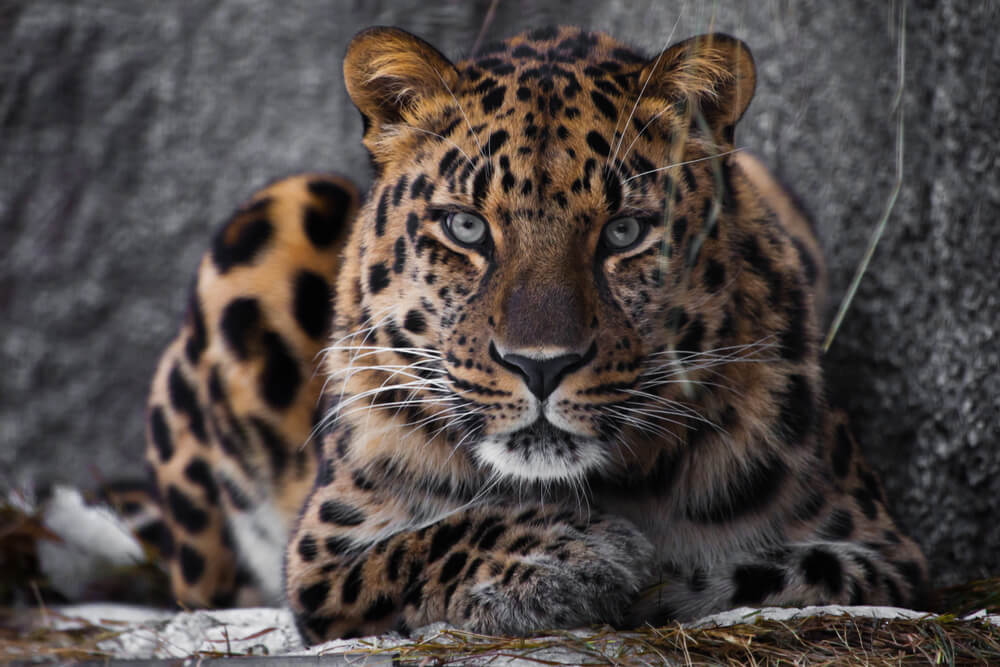
38. Amur Leopard (Panthera pardus orientalis)
- Current ICUN Status: Critically Endangered
- Typical Location(s): China, Russia, North Korea, South Korea
- Diet: Deer, Livestock, Small Mammals, Rodents, etc.
Amur Leopards are some of the most beautiful animals you could ever see in the wild. However, it is quite rare you’ll come across one today. Sadly, the species is critically endangered due to habitat loss and severe poaching. The nations the leopard is native to have tried to make it as illegal as possible to sell the fur of these leopards. This is supposed to deter poaching, as the main function of the job is to sell the leopard’s fur.
Yet most of the time, it’s only illegal enough to get a fine without much else occurring. Most of the leopards seem to be killed by Russian hunters from small villages. These people do not have licenses or permits to hunt anything, so they hunt completely illegally. With the furs netting an $800 to $1,000 profit in 1999 and much more in 2019, it makes sense to for these smaller places to poach and deal with consequences later. But it’s killing such an impressive, amazing species of leopard.
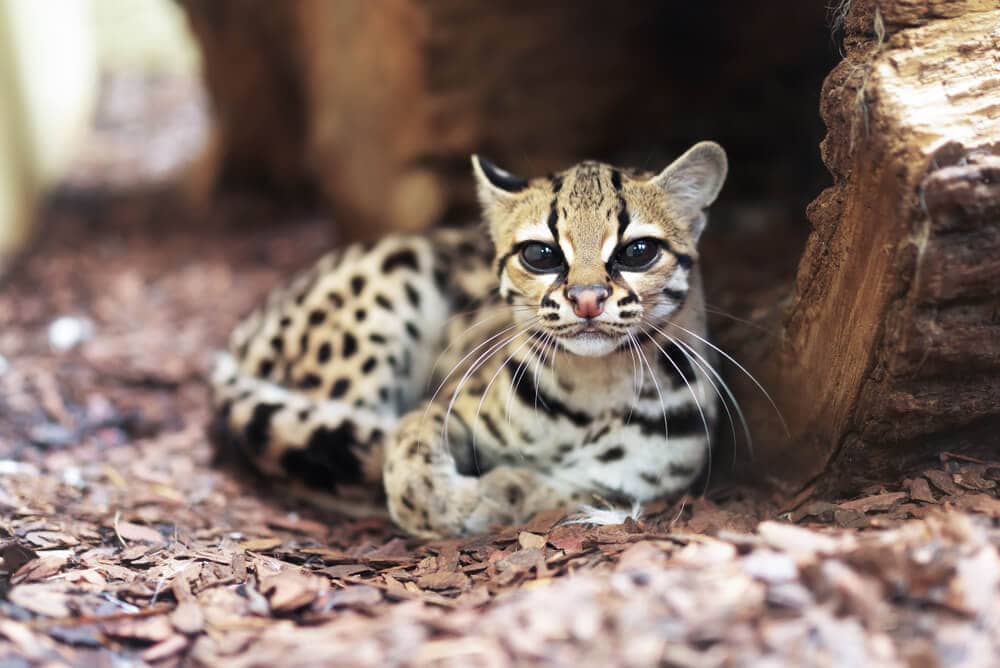
37. Margay (Leopardus wiedii)
- Current ICUN Status: Near Threatened
- Typical Location(s): All Over Central & South America
- Diet: Insects, Small Reptiles, Rodents, Birds, Monkeys
A Margay may often be confused for a small leopard cub, but they are actually full-grown when they reach their still very small size. You would not be off too much to assume it’s a leopard as Margays are from the leopard family of cats. They are simply the smallest species in that family. It’s good that they’re relatively small, as they likely need the smaller size. Sadly, Margays were once hunted to drastically low numbers. Thankfully, the poaching has decreased and they’ve bounced back.
Margays are great predatory cats due to being able to, despite their small size, kill just about anything they feel like. While they rarely go after huge animals, especially humans, they have been known to attack those they deem possible to take out. This means they may go for smaller versions of animals if they are isolated enough. Typically, however, they stick to the trees and other sectors where they hunt small reptiles, rodents, and insects. Though they’ll kill and eat certain monkeys too.

36. Serval (Leptailurus serval)
- Current ICUN Status: Least Concern
- Typical Location(s): Central & Southern Africa
- Diet: Insects, Rodents, Small Mammals, Snakes, Antelope, Birds, etc.
When you think of the Serval, it often comes off quite similar to the Margay. They are both smaller predatory cats but the Serval isn’t exactly as small as some assume. These cats are the smallest of the predatory cats in Africa, but you’d be wrong to assume they are pushovers. Servals are incredibly dangerous and can hang with the big cats of Africa. It’s quite common for certain animals to not assume as much from the smaller cat, which results in their imminent death.
Servals are incredibly fast and agile due to their smaller stature. Like other predatory cats, they also have sharp teeth and claws. To top it off, Servals are incredible jumpers and often escape poisonous snakes as a result. Servals do not mind going right for snakes however, regardless of if they are poisonous or not. They tend to go for smaller mammals and insects, but reptiles like snakes are a common food source too. They’ll also take down and eat antelopes and duikers too!
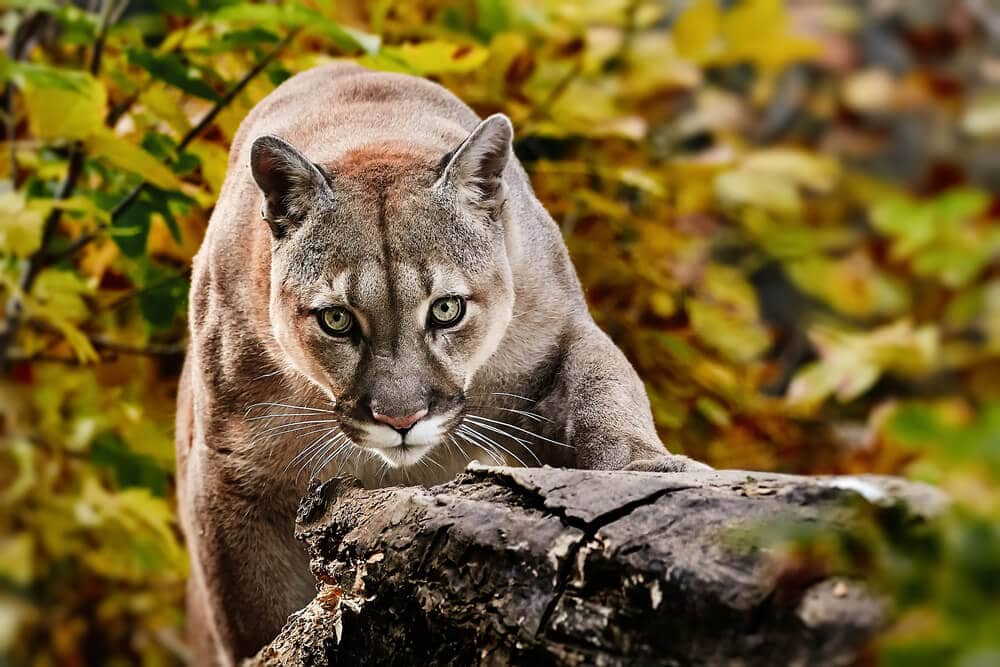
35. Cougar (Puma concolor)
- Current ICUN Status: Least Concern
- Typical Location(s): North & South America
- Diet: Deer, Wolves, Alligators, Bears, Deer, Elk, Moose, Sheep, Goat, Livestock, and much more
Cougars are often called pumas, red tigers, catamounts, as well as mountain lions. These predatory cats are found all over both North and South America and everywhere in-between. Due to the variety of looks these cats have shown, new names were given to them. Yet they are the same type of cat. However, they may differ in size and markings somewhat too. The Puma Concolor is the biggest of the entire Cougar species and is located mostly in North America.
They may appear different in both color and size depending on where you find them. Since they appear different all over, new names were often given. All of the Cougar species are considered ambush predators, capable of hunting and killing nearly anything they choose to go for. Cougars need meat to survive, so they cannot live off just insects, fruits, and vegetables. They do not tend to go for humans in the wild, but they will attack them if hungry enough.
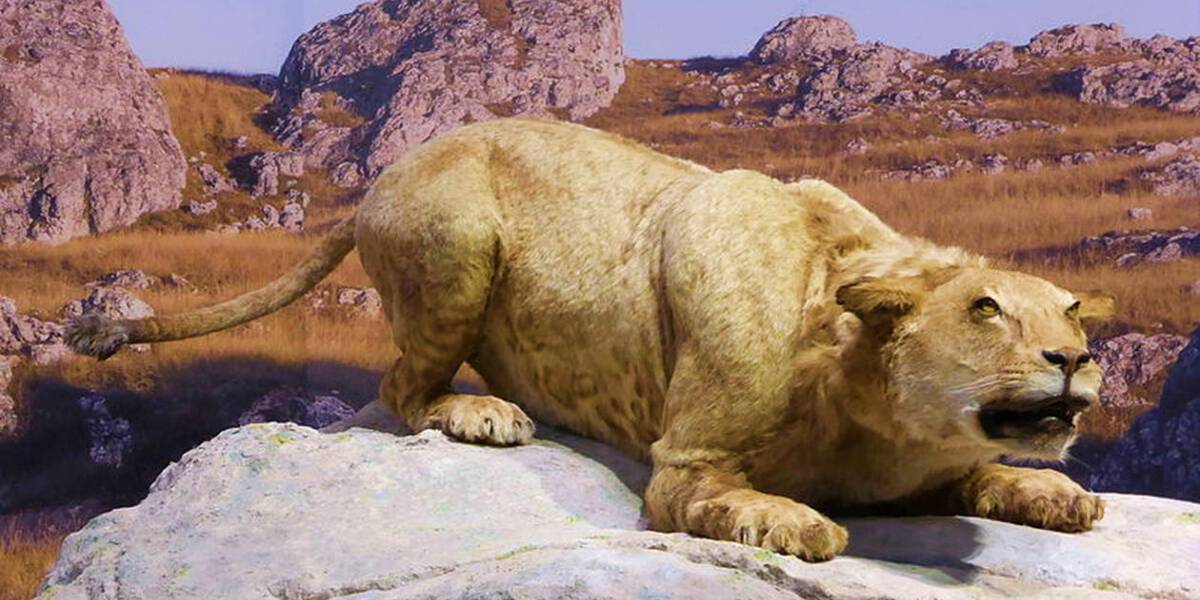
34. Cave Lion (Panthera spelaea)
- Current ICUN Status: Extinct
- Typical Location(s): Mostly spread out through Asia & Africa, partly in North America
- Diet: Most likely anything that did not eat them first
Cave Lions were often called Eurasian or European cave lions mostly due to being in both areas. They get their name for an understandable reason. These lions did not necessarily live a lot in caves, but rather, the fossils of the species have only been found in caves. This makes many assume that, if the fossils ended up here, they had to likely live in these caves or end up in them when they were close to passing away.
These lions lived up to around 12,000 years ago and belong to the Cromerian Interglacial Stage of animals as well. All of this being known, the species likely did not look like other lions. Their hair was way different it seems. While they had a similar color to lions we know, it was much thicker throughout. This was likely needed to live in and out of these cooler areas of the world. They were also far larger than lions of today, likely even considered gigantic in comparison.
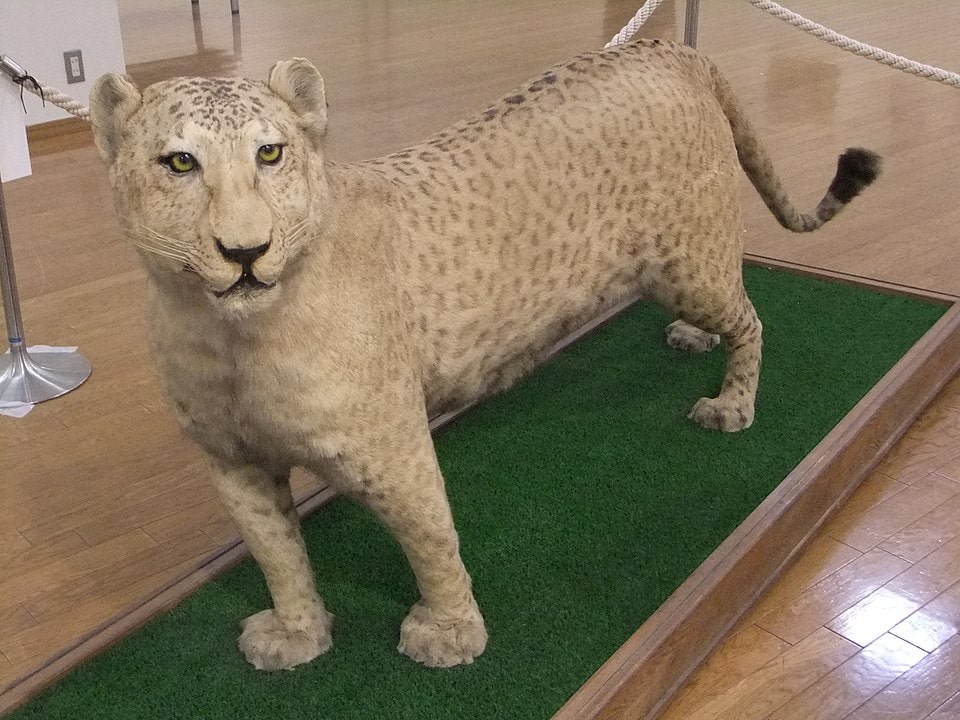
33. Leopon (Leopard/Lion Cross-Species)
- Current ICUN Status: Nonexistent
- Typical Location(s): Zoos Only Today, First Spotted In India
- Diet: Anything It Can Get
A Leopon is a hybrid species that happens to be a cross between a male leopard and a lioness. The hybrid was first seen in India in 1910. It was purposely bred there and was eventually notable due to being such an amazing cross-species. It was also one of the first known cases of captive breeding between two big cat species.
Male and Female versions of the Leopon can look different, but the most common thing you’ll notice about them is that the head often looks like that of a lion. The remaining portion of the animal is spotted like that of a leopard. Naturally, the creature gets to be quite a bit larger than the average leopard. They do have characteristics of leopards despite their size differences, such as loving the water and having superior climbing skills. The males also have thick manes that can reach 20cm in length.
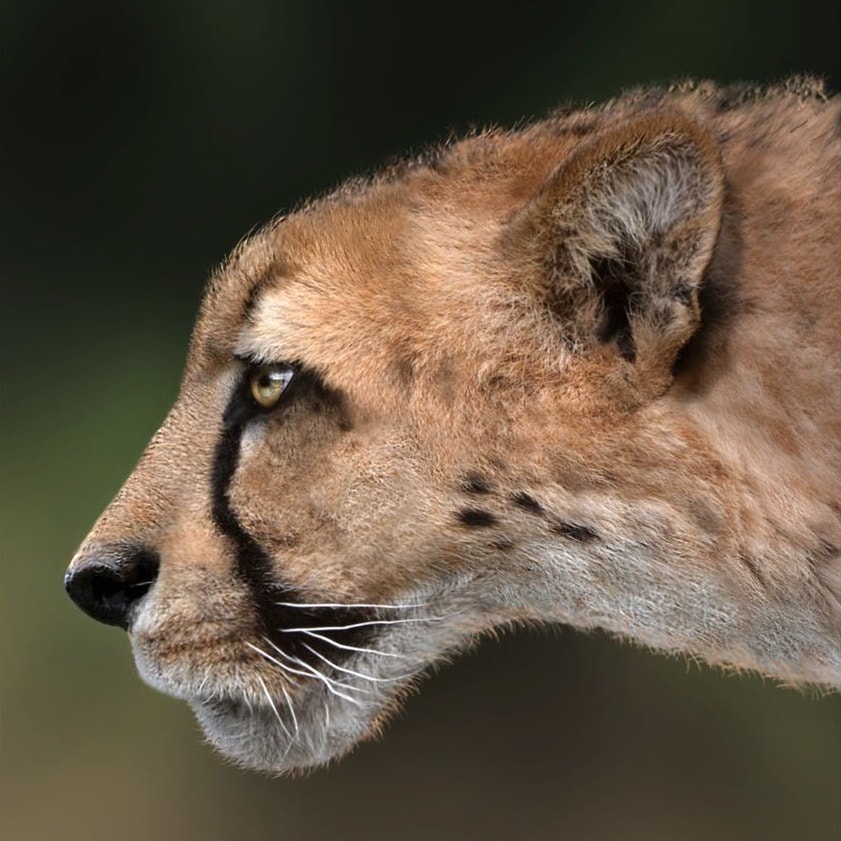
32. Giant Cheetah (Acinonyx pardinensis)
- Current ICUN Status: Extinct
- Typical Location(s): Modern-Day Germany, France, China, & India
- Diet: Mostly Anything
The Giant Cheetah is closely related to the modern cheetah we know today. However, as the name suggests, it was quite a bit larger than our modern-day friend. It is said that the Giant Cheetah species was around double the size of today’s cheetah with a height similar to that of a modern-day, full-grown, male lion. Giant Cheetahs were also notable sprinters, considered quite fast for their time. Due to being a much bigger version of cheetah, it was likely a lot slower than the cheetah of today.
It was a considerable foe for animals to deal with and likely one of the top predatory cats of its time. It lived during the Middle Pleistocene period, putting it between the window of 781,000 to 126,000 years ago. How was this Cheetah so large and today’s somehow smaller? It’s possible oxygen levels for the time aided this, as it’s the main reason for the large size of dinosaurs as well as other massive versions of plants and animals of the past too.
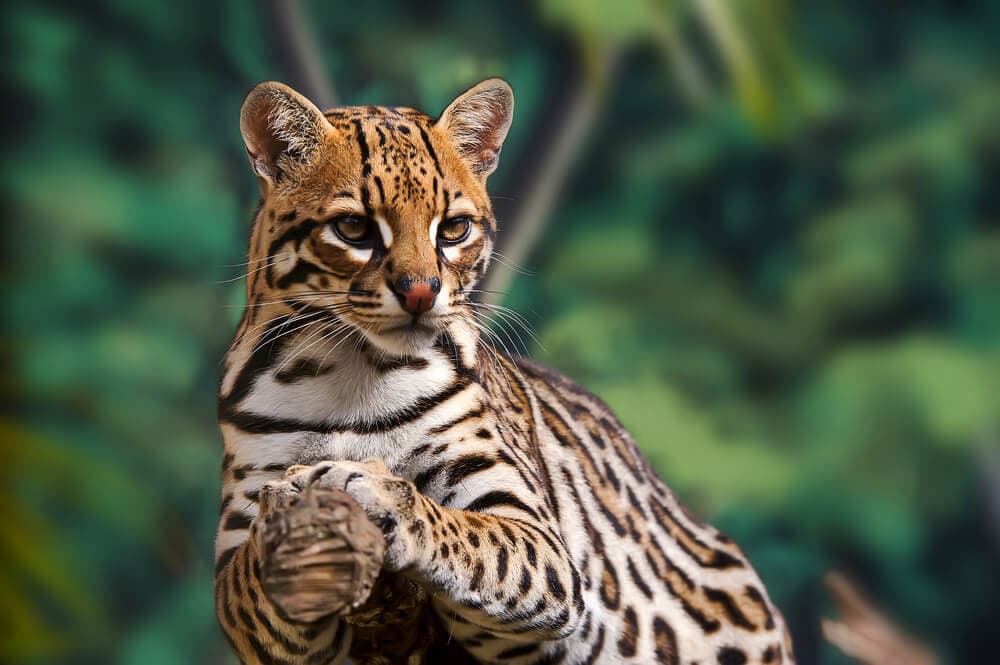
31. Ocelot (Leopardus pardalis)
- Current ICUN Status: Least Concern
- Typical Location(s): North & South America
- Diet: Rodents, Armadillos, Possums, Rabbits, Insects, & Some Small Reptiles
Ocelots come from the leopard side and it’s clear to see by their spots. They are notably smaller than most cats but they are insanely dangerous. Some make the mistake of assuming they’re like a common house-cat, as they only get slightly larger than most of them. However, they have much sharper claws and teeth than the average house-cat and ultimately need meat and not cat food to survive.
The Ocelot species is known to be incredible hunters, mostly hunting small game like possums, armadillos, rabbits, and small rodents. Sadly, Ocelots are often hunted by poachers all over the Americas. However, South America seems to be where they most often deal with them. This has put the Ocelot on the ICUN threatened species list over the years but thankfully the population has bounced back. Mostly due to efforts of conservationists, new laws, and bans on the sale of their fur.

30. Caracal (Caracal caracal)
- Current ICUN Status: Least Concern
- Typical Location(s): Africa, Middle East, Central Asia, & India
- Diet: Birds, Rodents, Rabbits, Sheep, Goat, Antelope, Common Duiker
Caracals are some of the most impressive predatory cats in existence. They are often related to cougars due to having a similar look to them. Yet they also have a similar appearance to that of the Lynx family of cats. Ultimately, Caracals separated themselves from the other cat families due to being so different that they could not be defined by the same characteristics or full appearances as the others.
They were first scientifically described by German naturalist Johann Christian Daniel von Schreber in 1776. He found that the creature had long, sharp, canine-like teeth along with a robust build, and tufted ears. Today, we know that Caracals are different from many predatory cats in that they prefer to live alone. Like others, they are very territorial. Of medium-size, they tend to hunt for animals smaller or similar size but have been known to go after some incredibly big game before as well.
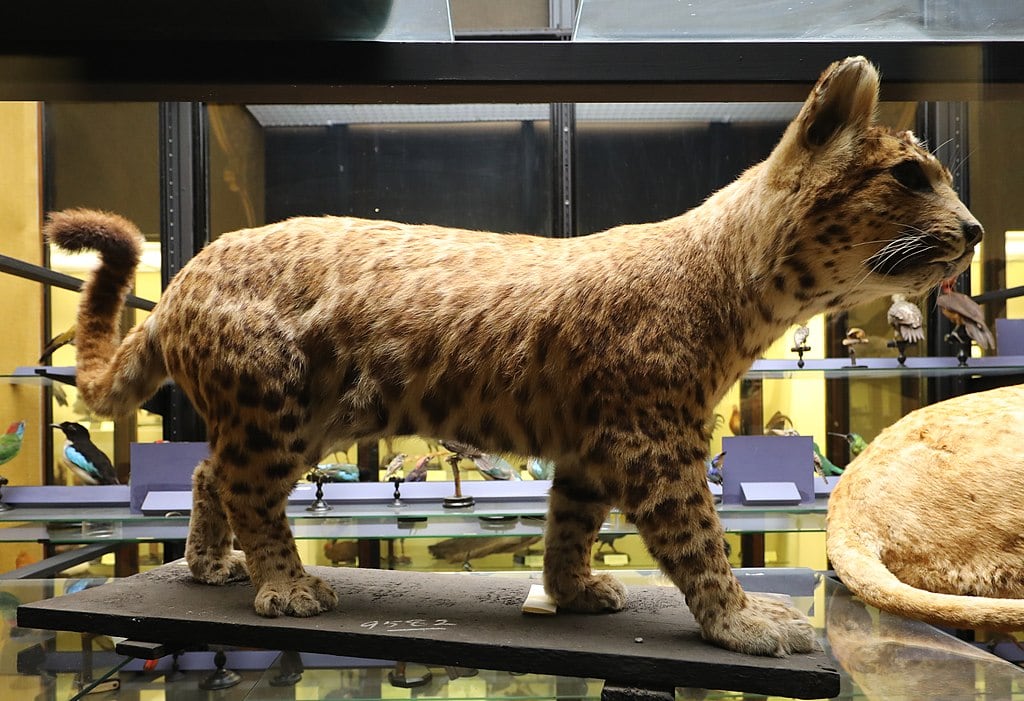
29. Pumapard (Puma/Leopard Cross-Species)
- Current ICUN Status: Nonexistent
- Typical Location(s): Zoos All Over The World
- Diet: Various Zoo meals, rodents, small mammals, etc.
While hybrid species like Pumas and Leopards would be unlikely without zoos pushing breeding programs, it is possible they’d breed together. Unlike some other hybrid pairings, genetics and general make-up are not too far off to cause problems in the offspring created. Pumapards occur when a male puma breeds with a female leopard and was first performed in the 1890s. 2 cubs were born in a Chicago area zoo in this time period, and both hybrid cubs survived to adulthood.
Eventually, 3 sets of twin cubs were born a few years later in Hamburg, Germany. One thing common amongst all the Pumapards was that they had a tendency to be born with dwarfism. This made it to where they’d grow nowhere near the size of an adult Puma or Leopard. They held appearances to both parents, with a build or look to the Puma and spots of the leopard, as well as sprinting/climbing ability. Also, unlike other hybrids, both males and females can produce offspring.
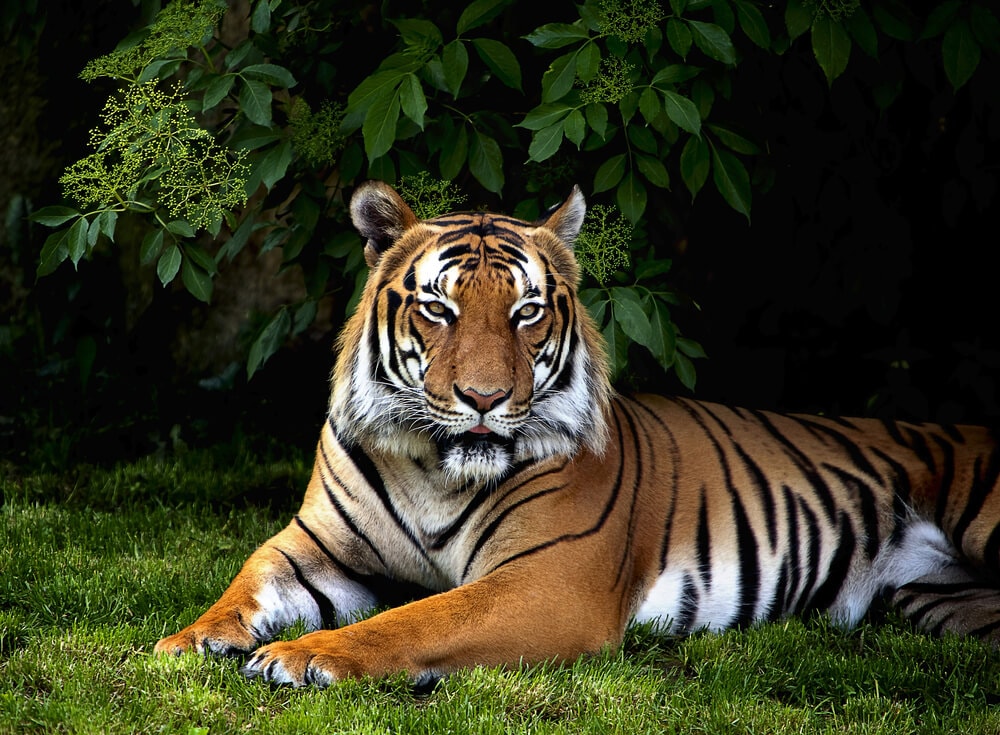
28. Sumatran Tiger (Panthera tigris sondaica)
- Current ICUN Status: Critically Endangered
- Typical Location(s): Island of Sumatra
- Diet: Anything They Get Their Paws On
As their name suggests, Sumatran Tigers are typically native to the Indonesian Island of Sumatra. Several animal species live here that are either endangered, critically endangered, or on the brink of extinction. Some have even gone extinct here. A lot of this has to do with the isolated issue of the island on top of mankind causing issues with deforestation and habitat loss. The Sumatran Tiger is notable for being nearly wiped out from issues like this as well as poaching.
It is currently the last remaining tiger species part of the “Panthera tigris sondaica” family of tigers. The others (the Bali and Javan Tigers) have been extinct for quite some time. It is also the last Tiger species of any kind in the Sunda Island region. It is still quite a strong, capable animal despite the low numbers. Sumatran Tigers stand out with their darker coloring and longer black stripes. Despite their seemingly large size, they are actually one of the smallest tiger species on the planet today.
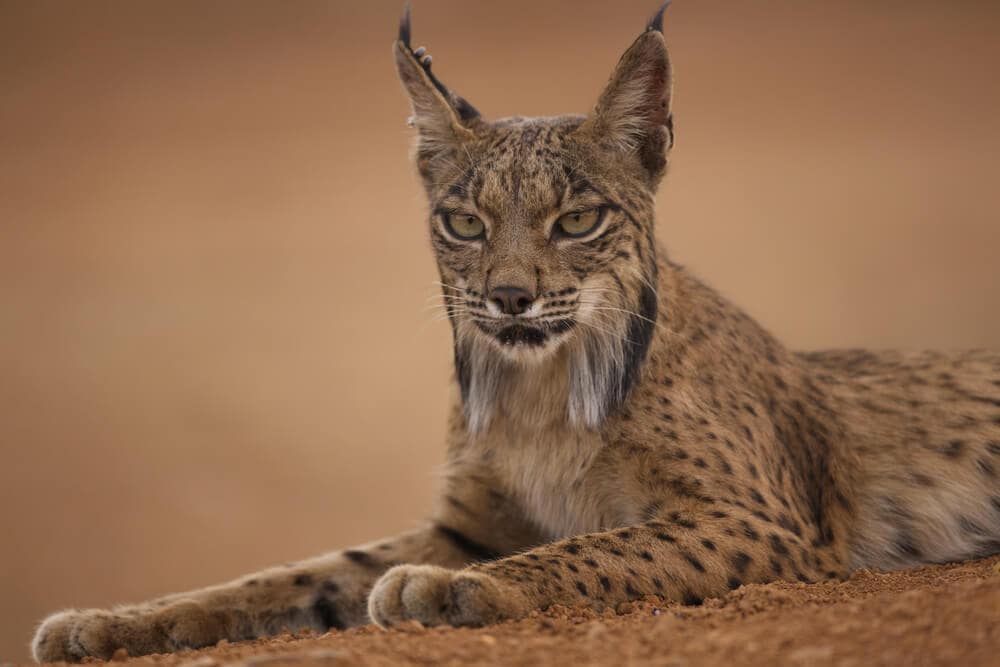
27. Iberian Lynx (Lynx pardinus)
- Current ICUN Status: Endangered
- Typical Location(s): Iberian Peninsula
- Diet: Rodents, Small Mammals, Common Genet, Mongoose, Snakes
The Iberian Lynx and Eurasian Lynx are often assumed to be from the same Lynx species line and this is partially true. The two came out of Central Europe during the Pleistocene period but the Iberian Lynx evolved to become its own distinct species by the Late Pleistocene period. This was around 11,700 years ago. This subspecies is notable due to its appearance, making it come off distinctly as a Lynx but differing it from others at the same time.
The Iberian is actually a bit larger and usually has a tawny to yellowish coloring, with the classic Lynx spots. The Iberian has short yet powerful legs, allowing it to chase down certain animals and even climb trees. This also allows them to jump at relatively good heights. They hunt numerous small mammals as well as rodents and rabbits. It’ll even hunt, kill, and eat other carnivorous animals like mongoose, red fox, and the common genet. Due to poaching, the species is sadly endangered.
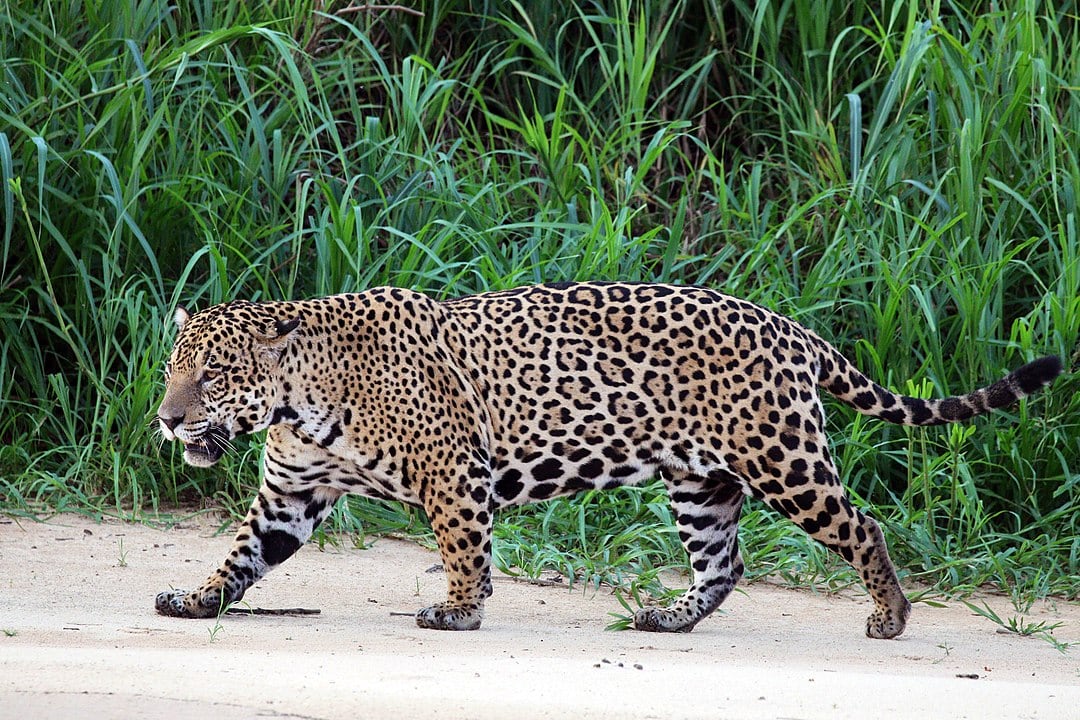
26. South American Jaguars (Panthera onca Hernandesii, Onca, Paraguenis, Peruviana)
- Current ICUN Status: Endangered
- Typical Location(s): Central & South America
- Diet: Wild Boar, Armadillos, Possum, Tapir, Caiman, Primates, & Local Livestock
We’re kind of cheating with this one as we’re listing an entire subspecies of Jaguar and not a specific one. The reason for this is that none truly stands out as better or worse than any other. The list of South American Jaguars includes the Central American Jaguar, East Brazilian Jaguar, Paraguay Jaguar, and Peruvian Jaguar. These Jaguars can come in several different looks and appearances overall.
Most of them are notable for their yellow coloring with black spots, but some have a darker yellow coat. There are black jaguars as well. Though these are quite rare. All of the South American Jaguars are in an endangered species point due to poaching and habitat loss. However, the black jags are the most critically endangered amongst them. Jaguars are notably larger than most of the Panther species, but their diets are nearly exact.
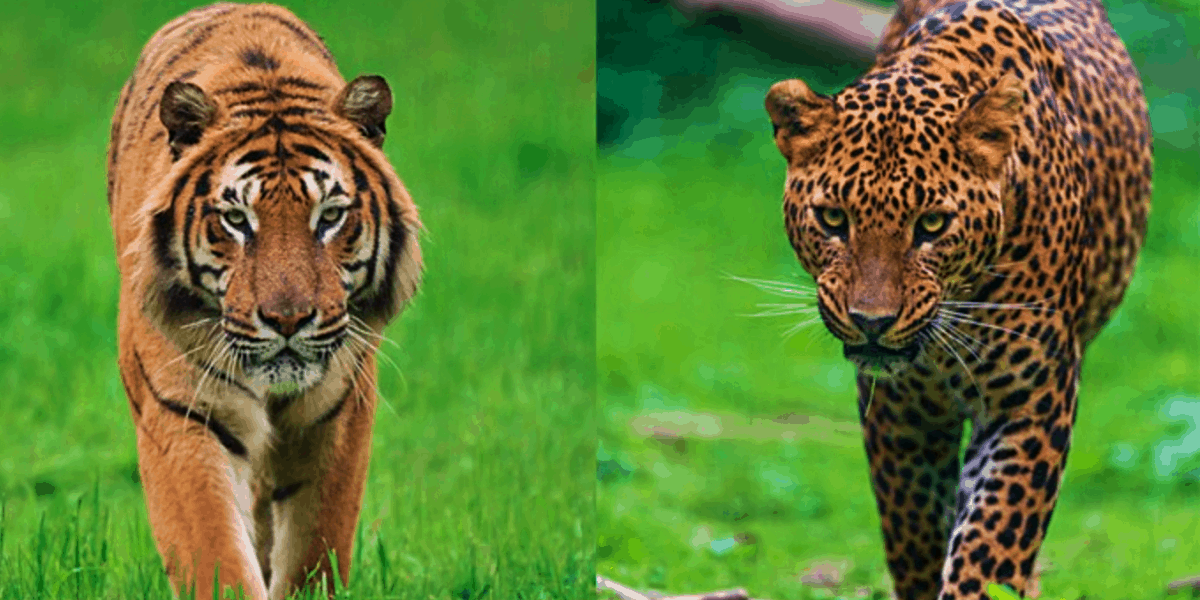
25. Tigard (Tiger/Leopard Cross-Species)
- Current ICUN Status: Nonexistent
- Typical Location(s): Zoos & Portions of India
- Diet: Mostly Anything
A Tigard is a hybrid species of big cat that is a cross between a male tiger and a leopardess, or female leopard. Hybrids of Tigers and Leopards are relatively rare, even in zoos. In India, there have been rumors of leopards and tigers mating but this typically happens with a male leopard and tigress and not a male tiger and leopardess. There’s an over 50-pound weight difference, not to mention height, between the two. Mating is relatively hard to do as a result.
The biggest known account of this hybrid occurred in 1977 at the Southam Zoo in Warwickshire, U.K. A tigress gave birth to one there which had a face like the Tiger mother but a body like the father leopard, spots and all. The reverse is often in play with Tigards. Most of the natural Tiger/Leopard hybrids are hard to come by these days. This is especially true in India where the populations are so bad with these predatory cats, they may never breed outside their specific species again.
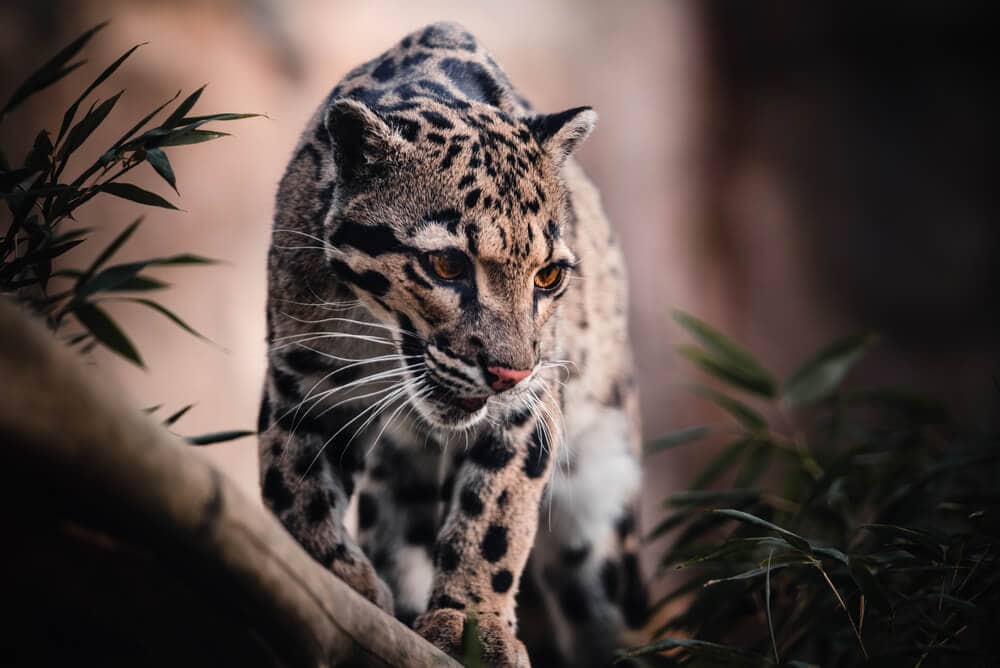
24. Clouded Leopard (Neofelis nebulosa)
- Current ICUN Status: Vulnerable
- Typical Location(s): Southeast Asia, The Himalayas, & China
- Diet: Deer, Pheasants, Porcupine, Pangolins, etc.
Clouded Leopards truly stand out massively in the leopard family of predatory cats. While they have many similarities to the other leopards, they differ in several ways. Other leopards have long canines, but Clouded Leopards have exceptionally long ones. This has resulted in this leopard species getting the nickname of a “modern-day saber-tooth tiger.” However, the biggest thing that makes the Clouded Leopard stand out is the appearance overall.
Unlike other leopards that are spotted throughout, Clouded Leopards have large irregular splotches. The splotches are often black to dusky-grey, usually depending on the main fur color. This tends to be dark grey or an ocherous ground coloring. This species of leopard can typically be found in the Himalayas as well as areas near here such as China. They eat things like pheasants, deer, pangolin, porcupine, and several primate types. The species is also sadly vulnerable due to poaching.
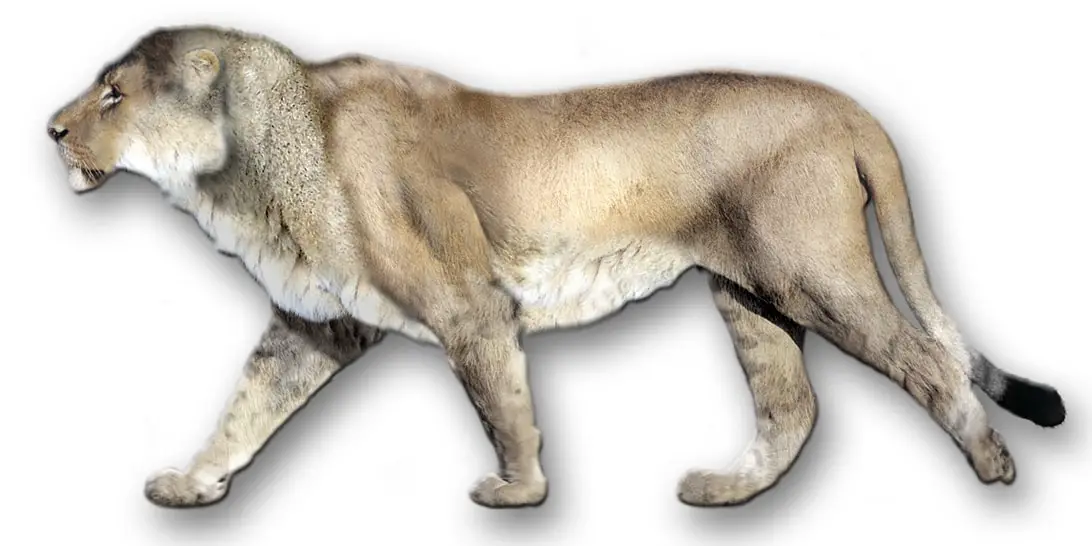
23. American Lion (Panthera atrox)
- Current ICUN Status: Extinct
- Typical Location(s): Modern-Day North & South America
- Diet: Anything They Had Available
American Lions are an extinct species that lived during the Pleistocene Epoch period, which is roughly 340,000 to 11,000 years ago. We know of the species due to fossils being discovered all over North America, from Alaska to Mexico. It just so happens that the Cave Lion (as mentioned previously) was a sister lineage to the American Lion. Both are, of course, extinct. The question for some might be, what led to their extinction? Man and Climate Change may have played a key role.
Due to mankind coming into their own near this time period, it’s likely they were hunted. However, the last major Ice Age (yes, there is more than one) is possibly the biggest cause of their extinction in North America. Although some American Lions lived in some impressively cold temperatures, living as far north as Alaska and various parts of Canada. They were also around 25% larger than modern-day lions yet did not have the impressive mane we see with African Lions today.
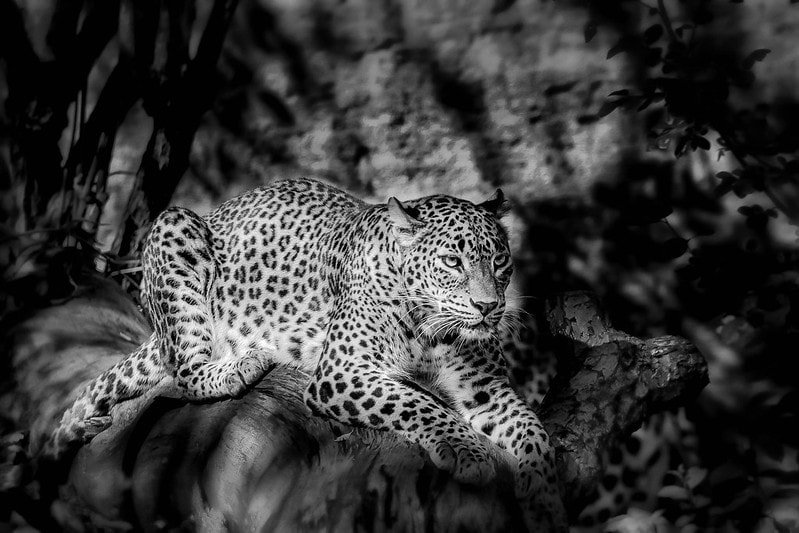
22. White Panther
- Current ICUN Status: Critically Endangered (Extremely Rare)
- Typical Location(s): All Over The World
- Diet: Mostly Anything Their Main Species Eats
Again, we’re sort of cheating here too. However, we do feel is only right to discuss the white version of the predatory cats out there today. The term “white panther” is a bigger term than people might assume. This covers the white-colored versions of Jaguar, Cougar, or Leopard. Since the “panther” term includes multiple big predatory cats, it’s kind of a large sector to discuss honestly. How do white versions of these species exist? It’s actually quite interesting.
Some are, of course, albino. However, others have Leucism or Chinchilla Mutation. Both are random just as much as albinism. Black Panthers often need to be selectively bred to achieve their black coloring but White Panthers, due to these issues, can happen quite literally at random. Although, if bred with other White Panther types, they can have white-colored offspring. Many whites have trouble hunting due to their color, so they often die quicker, rely on groups, or live in zoos.
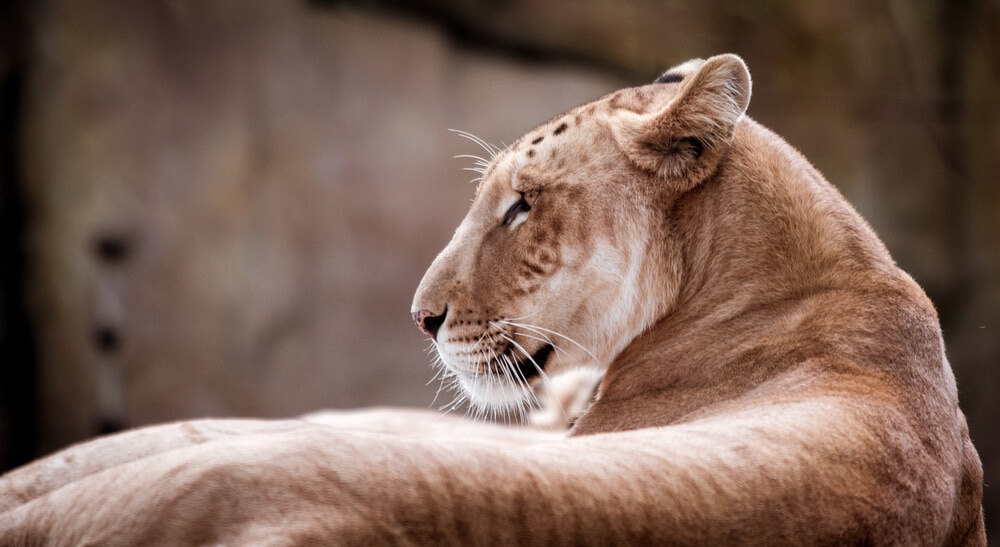
21. Tigon (Tiger/Lion Cross-Species)
- Current ICUN Status: Nonexistent
- Typical Location(s): Zoos, Captivity
- Diet: Anything Fed To Them
Tigons are a special bred, hybrid species of predatory cats that are quite impressive. They are a cross between a male Tiger and a Lioness, or female lion. The original Tigon was bred decades ago but happened to be in poor health right away. Though it managed to make it to adulthood, it never was capable of mating. We long thought that Tigons were unable to mate at all. However, this is both true and false. Tigons are unable to really mate amongst themselves.
However, female Tigons can breed with regular tigers and lions. Unlike other hybrid species, Tigons are not born with many genetic issues. However, they have some characteristics of both parents. Due to the male side being a Tiger, the Lion mane will not be prominent but it can grow. They will have the Tiger stripes but not as prominent as they’d be in normal tigers and they often take on the coloring of the Lioness. Sadly, there are no Tigons in the wild as they are all exclusively bred in captivity.

20. Trinil Tiger (Panthera tigris trinilensis)
- Current ICUN Status: Extinct
- Typical Location(s): Indonesia
- Diet: Pretty Much Anything
The Trinil Tiger is one of the most interesting Tigers from ancient history that we know of. The reason we and others find them so interesting is that we simply do not know much about them. It’s one of those “mystery making us want more” type of things seemingly. Fossils have been found and studied extensively on the Trinil Tiger, but we don’t know a lot. Thus far, we know the species dates back to 1.2 million years ago. We also know they went extinct around 50,000 years ago.
As the name suggests, it was located around the Trinil area mostly. Despite their location in Indonesian island territories like Java, they are actually not thought to be ancient ancestors to the tiger species that came to this area after them, such as the Bali or Javan Tigers. Although some believe they could be ancestors to ALL Tiger subspecies found in Indonesia, it’s unknown. A lot of early Tigers migrated to warmer environments through the various Ice Ages, so you never know.
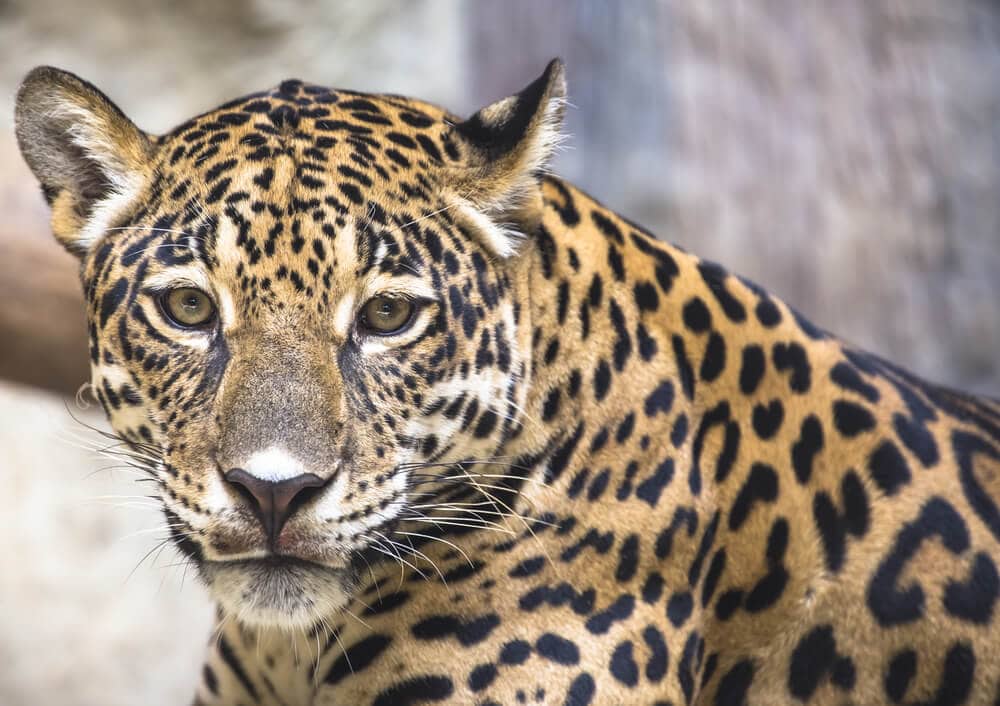
19. Jagulep (Jaguar/Leopard Cross-Species)
- Current ICUN Status: Nonexistent
- Typical Location(s): Zoos, Captivity
- Diet: Whatever They Are Fed
They go by many names, the Jagulep, Jagleop, and even the Jagupard. However, they are all the same thing. It’s a cross-species hybrid between a Jaguar and Leopard. Unlike other hybrids, species like Leopards and Jaguars can possibly run into each other in the wild. However, it is quite rare that they’d ever mate unless in captivity. You get a Jagulep with a male Jaguar and a female Leopard. Meanwhile, a male leopard and female jaguar create a Leguar or Lepjag (male names are always first).
The main difference between these two species of hybrid is truthfully just their appearance. Male genes typically take over for the coloring, but since both have spots, each of these hybrids is born with a good bit of them that remain into adulthood. Black jaguars have also been useful in creating black versions of the species since this is a recessive trait. This means that males likely have the dominant genes in most appearance materials. Yet the bodies of these creatures tend to go toward the mother.
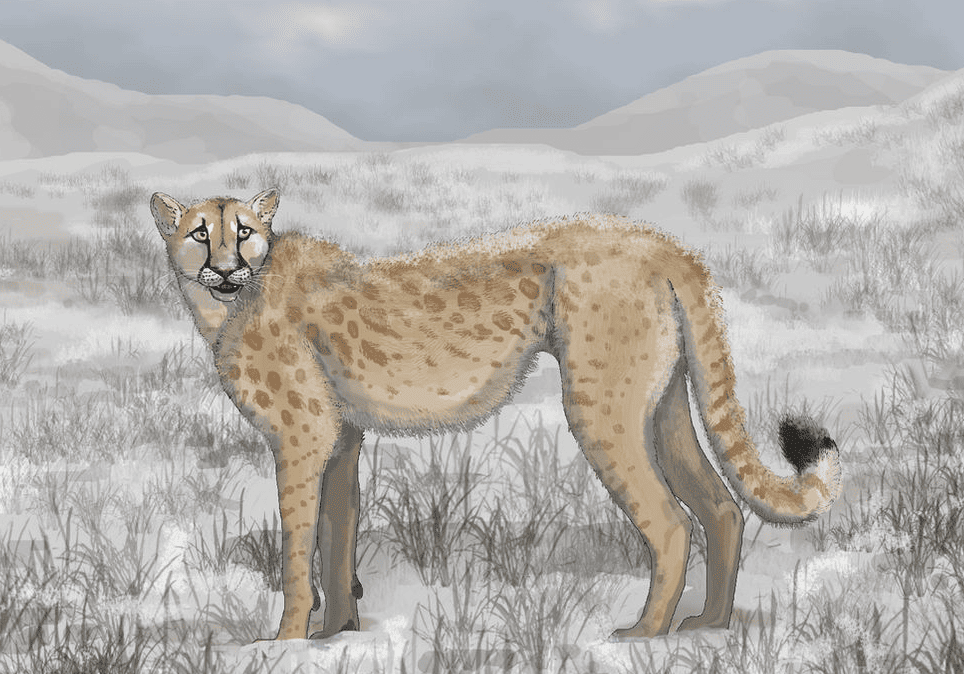
18. American Cheetah (M. Inexpectatus, M. Trumani, M. Studeri)
- Current ICUN Status: Extinct
- Typical Location(s): North America
- Diet: Mostly Anything
To be correct with history and science, there were technically three versions of the American Cheetah that existed during the Pleistocene epoch. Those are the M. Inexpectatus, M. Trumani, and M. studeri. We know from fossils and other material uncovered about them that they were a lot like the modern-day cheetahs. They had expanded nasal cavities for increased oxygen as well as legs meant for long-distance and fast running.
They were also larger than the average cheetah of today and were thought to have bodies like that of a modern-day cougar. The largest of the species were found to have been a little over 200 pounds. Meaning they were likely nowhere near as fast on their feet as modern-day cheetahs. What is so incredible about this is that they were closer in relation to Cougars than cheetahs, despite their name. This is likely why Cougars are still in the Americas but cheetahs are nowhere to be seen.
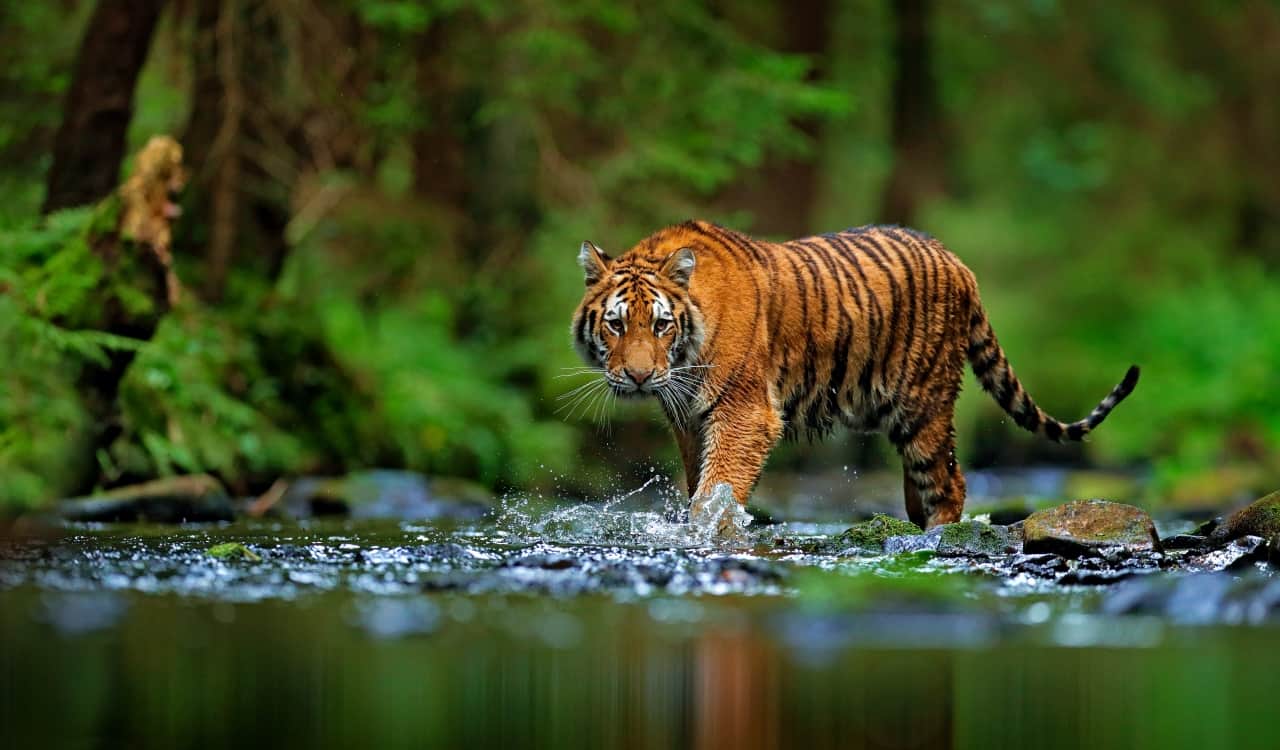
17. Bengal Tiger (Panthera Tigris Tigris)
- Current ICUN Status: Endangered
- Typical Location(s): India, Bangladesh, Nepal, Bhutan
- Diet: Boars, Water Buffalo, Deer, Porcupines, Rabbits, Large Ungulates, Wolves, Leopards, Jackals, Foxes, etc.
When bringing up some of the greatest predatory cats in history, Bengal Tigers are often on everyone’s list. They have been used in ancient literature and they were massive parts of ancient history. This is likely due to the tiger’s specialized location that put them in the heart of where a ton of action took place. Seriously, there are only two true tiger types people think about when they picture a tiger. The Bengal is always one of them.
Bengal Tigers are mostly native to India but have often made their way around the territory for hundreds of years too. This has even allowed them to end up in places like China and Russia. This species is notable for their yellow to light orange coats and dark, prominently large stripes. They are major apex predators who are known to both get along with and kill humans. The species is sadly endangered due to the growth of India as well as horrible poaching. Fewer than 6,000 remain today.
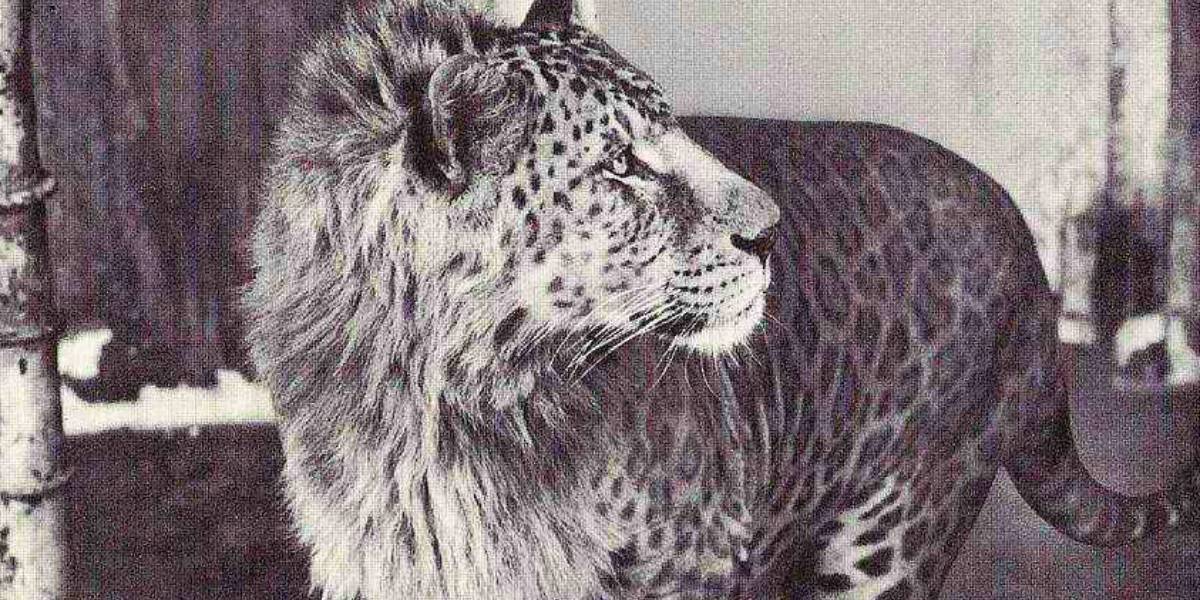
16. Jaglion (Jaguar/Lion Cross-Species)
- Current ICUN Status: Nonexistent
- Typical Location(s): Zoos, Captivity
- Diet: Whatever They Are Fed
While both Jaguars and Lions are part of the panther species of predatory cats, they likely would never cross paths in the wild nor mate with each other. The male genes typically take over the major appearance, which results in the Jaguar’s spots being prominent in Jaglions. Although they are brown in color like the Lioness, they are still built with the powerful jaguar body overall. The coloring from the father will, however, go to the child over the Lioness’ brown coloring at times.
Black Jaguars will pass on their black melanism gene to at least one or more cubs born, which is always the case with twin Jaglions. One will be black and spotted but may develop some other Lioness traits. Thus far, the species does not seem to have any major health complications like some hybrids. They also grow properly without any real trouble but most males do tend to be sterile while females can have cubs with other main big cat types like lions, jaguars, and leopards.
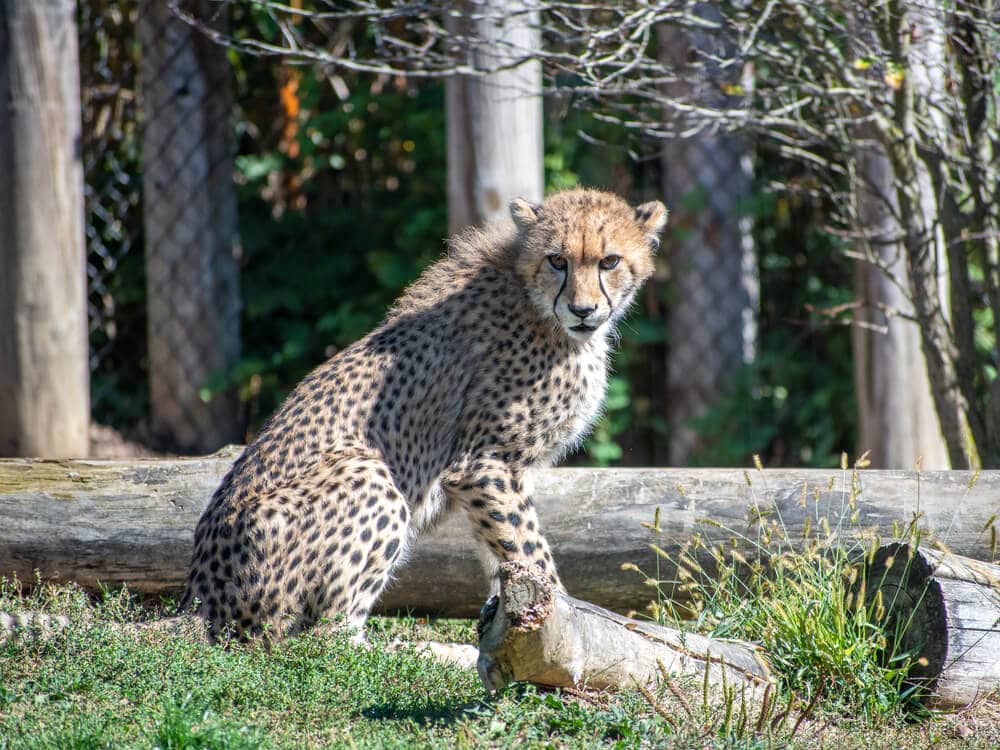
15. Asiatic Cheetah (Acinonyx jubatus venaticus)
- Current ICUN Status: Critically Endangered
- Typical Location(s): Only In Iran Today
- Diet: Gazelle, Sheep, Goat, Rabbits, Onagers
The Asiatic Cheetah is often forgotten due to the biggest section of the species being located in Africa. However, these cheetahs are quite impressive and well worth knowing about. The species actually came out of the African version when some of these cheetahs decided to head into the Asian territory at some point between 32,000 and 67,000 years ago. How do you tell the difference between the two? Asiatic Cheetahs have much smaller mane in comparison to their African counterparts.
They also have a lighter coating due to the habitat they live in and they are a little bit taller, with longer limbs. Both are spectacular runners, but it’s possible that the Asiatic could be faster than the African version due to being lighter and taller. Funny enough, Asian Cheetahs are not very temperamental, allowing humans to tame them easier. Some people even used them like hunting dogs. Sadly, this species is critically endangered due to loss of habitat and poaching.

14. Liard/Lipard (Lion/Leopard Cross-Species)
- Current ICUN Status: Nonexistent
- Typical Location(s): Zoos, Captivity
- Diet: Whatever They Are Fed
We brought up the Leopon earlier, which is the hybrid species created with a male leopard and a lioness. However, the flip side of this results in what is known as a Lipard or Liard. This is when a male lion breeds with a female leopard. The spots from the Leopard remain whether a male or female is involved. However, the biggest difference between adding a male lion versus a female to this is that mane will be noticeable in the male Lipards. They also have larger heads like Lions too.
The main issue with Leopardesses once they have a Lipard is the tail that the Lipard will grow, as it looks similar to that of a Lion. One leopardess bit off a Lipard’s tail, as it attempted to groom the cub but seemed to never be able to handle the tail side well. Both Lipard types are fertile with the males and females, unlike other hybrid species where just the female can breed.

13. Longdan Tiger (Panthera zdanskyi)
- Current ICUN Status: Extinct
- Typical Location(s): China
- Diet: Mostly Anything Available To It
The Longdan Tiger is actually known as an extinct panther species that had traits shared among various different panther types but they seemed to most resemble Tigers. Thus, the origin of their name. These Tigers were around the size of a modern-day jaguar. The species is extinct but also one of the first true tigers that walked the Earth. They date back as far as the Gelasian stage of the earliest Pleistocene period.
This dates them back 2.16 to 2.55 million years. The first Longdan Tiger was discovered off the Longdan slope in China, which gives you another origin to the name. It belongs to the ancient version of the Pantherine Species of animals, most of which have gone extinct with close ancestors still living today. Ultimately, the Longdan Tiger is special compared to others for being the closest version of a modern-day tiger that lived millions of years ago. On top of being one of the first.
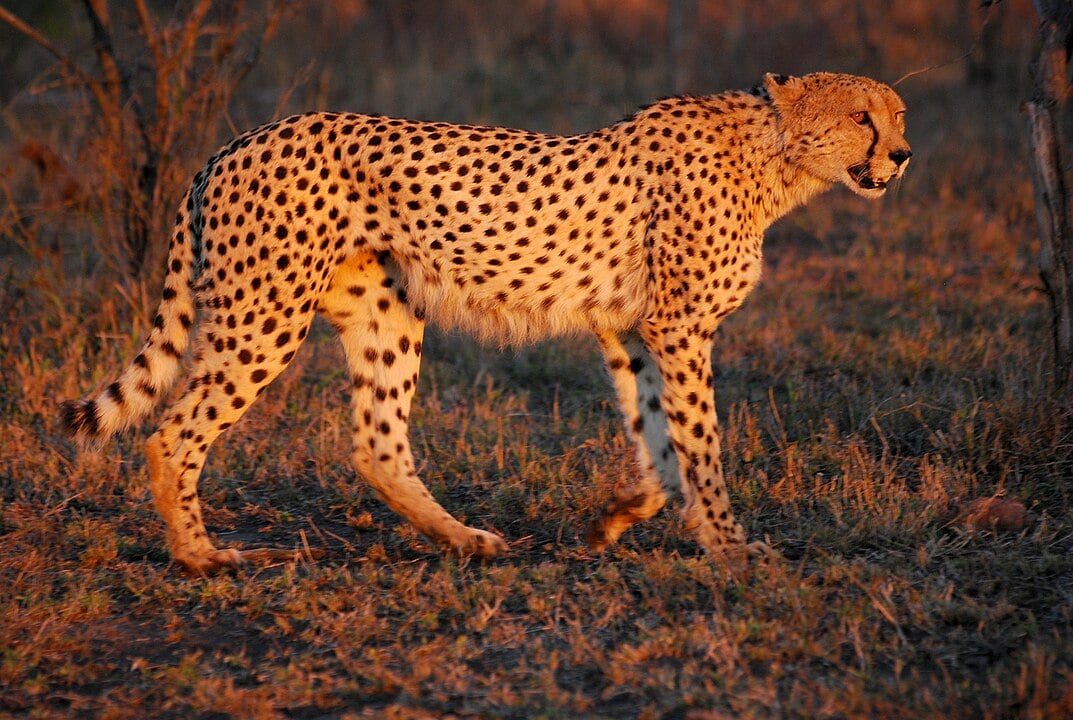
12. African Cheetah (Acinonyx jubatus jubatus, Acinonyx jubatus soemmeringii, Acinonyx jubatus hecki)
- Current ICUN Status: Each Are Vulnerable or Critically Endangered
- Typical Location(s): Throughout Africa
- Diet: Antelope, Hares, Wildebeest, Warthogs, etc.
We are yet again slightly cheating due to several versions of African Cheetah being present. There are three total, the East-Southern African Cheetah, Northwest African Cheetah, and Northwest African Cheetah. You might be wondering why there are three different versions of African Cheetah, especially when located on the same continent and likely coming across each other. Ultimately, this has only been done due to differences in their appearances.
For example, the East-Southern African Cheetah has a golden coat with black spots, white belly, and more pronounced spots on the face. The Northeast version is bigger than the rest, darker fur coloring that is also thicker, as well as a wild and inconsistent black spot pattern. The Northwest is very different with nearly white fur coloring, the face has virtually no spots, and it’s a bit smaller than the rest. Overall, each of these subspecies of the cheetah is vulnerable or critically endangered.
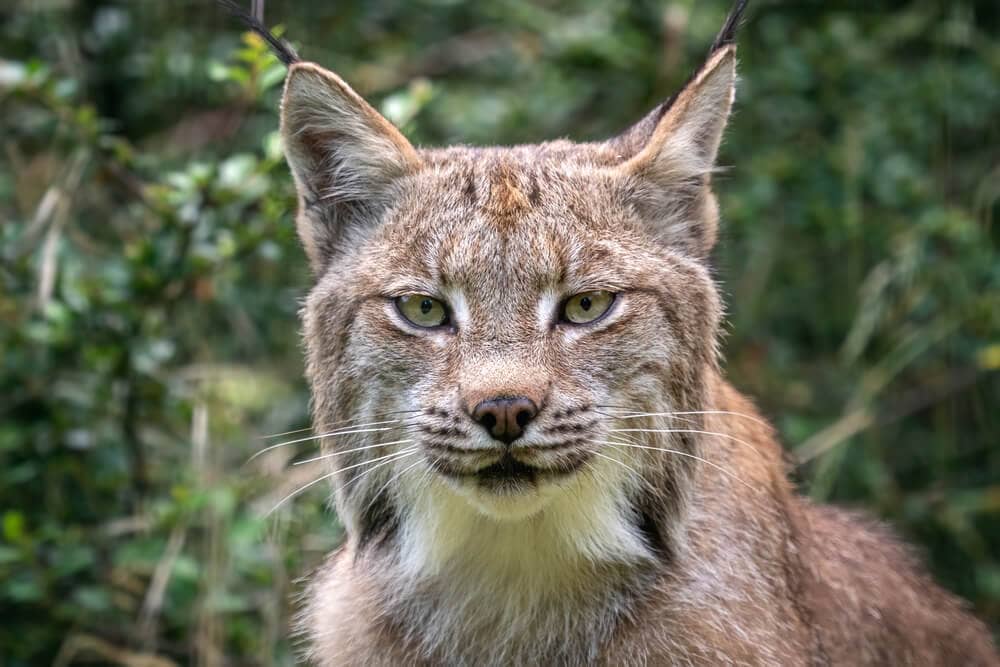
11. Canada Lynx (Lynx canadensis)
- Current ICUN Status: Least Concern
- Typical Location(s): North America
- Diet: Rabbits/Hares, Ducks, Squirrels, etc.
The Canada Lynx may be one of the most feared predatory cats in North America. It’s not due to the cat being insanely large and tough to deal with. Rather, this Lynx is relatively small like others in its species. In fact, it is only a little bit bigger than an average housecat if you cut the hair down a bit. What makes them feared is the way they look on top of their incredibly sharp claws and bone-snapping teeth.
They have 28 total teeth with 4 being long canines that can puncher pretty much anything or anyone they wish. In the back of their mouth, they have carnassial teeth on both sides. These teeth are very sharp and grind into the meat or bone of animals in an almost saw-like form. Canada Lynx rarely go near humans, mostly due to being a victim of poaching. This brought down the population drastically. They aren’t fans of humans and are quite territorial, so if you give them any reason, they’ll attack.

10. Liger (Lion/Tiger Cross-Species)
- Current ICUN Status: Nonexistent
- Typical Location(s): Zoos, Captivity
- Diet: Whatever They Are Fed
Ligers have existed off and on for decades but most of them tend to occur in captivity. Usually, Lions and Tigers tend to be on opposite continents in the wild. Lions are usually in Africa while Asia tends to have Tigers. This difference is key but it also has a role in how they each evolved. Tigers and Lions can both get quite large but it’s how they get large that matters. When female Tigers mate with male Lions, they create Ligers. Most Ligers tend to also end up with a form of unstoppable gigantism.
This results in the Liger getting to the height of the Lion but it ends up growing in mass like the Tiger. Yet in many, growing never stops. Due to traits occurring at once, Ligers become massive. They are the biggest of all predatory cats on Earth today. Due to Lions and Tigers evolving so differently, Ligers are often born with various health problems and even die much quicker than other big cats. They’d also never last in the wild. Male ligers are also sterile while the females, at times, can have cubs.
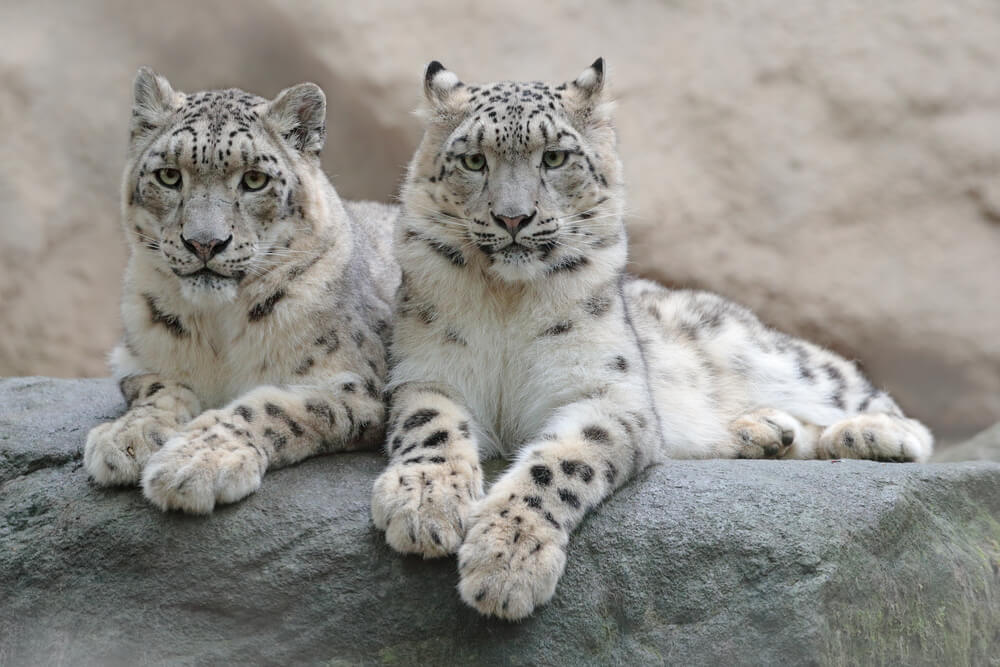
9. Snow Leopard (Panthera uncia)
- Current ICUN Status: Critically Endangered
- Typical Location(s): Afghanistan, China, India, Kazakhstan, Kyrgyzstan, Mongolia, Pakistan, Tajikistan, Nepal
- Diet: Deer, Monkey, Bear, Wild Boar, Sheep, Panda, & Livestock
While these predatory cats are known as the Snow Leopard, they’re not always white like snow. Of all leopard species, it does have the lightest coat, however. The coloring is light yellow with iconic, yet subtle leopard black spots. All blend very well into the environment. Contrary to popular belief, Snow Leopards also are not only located in mountain ranges. Although, this is where people can find them the most frequently. They are located throughout Central and South Asian territories.
While they inhabit alpine and subalpine zones up to as high as 14,800ft, they also are at much lower elevations. This is often near China and some of the northern nations. This seems to be due to two different types of Snow Leopards existing. One of which is at higher elevations while the other is at the lower, though both can switch things up too. Sadly, due to poaching, snow leopards are critically endangered. Thankfully, protected zones are present in several nations for them today.
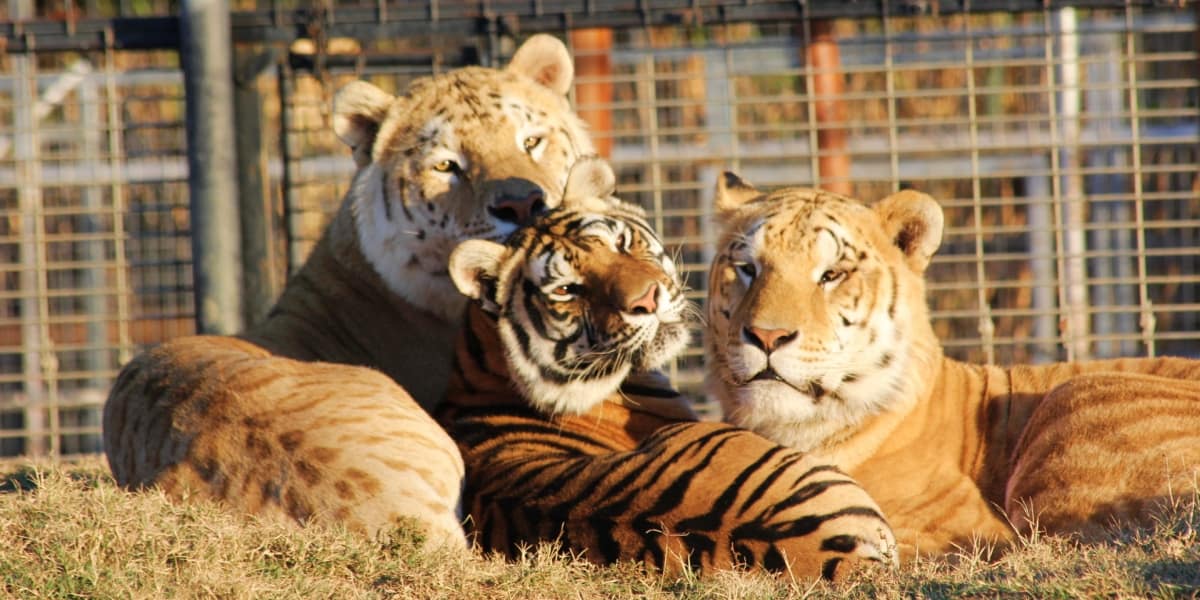
8. Ti-Liger (Tiger/Liger Cross-Species)
- Current ICUN Status: Nonexistent
- Typical Location(s): Zoos, Captivity
- Diet: Whatever They Are Fed
Ti-Ligers are the second generation hybrid big cat that is created when a male tiger mates with a female liger, or ligress. For many years, it was assumed Ligers were completely sterile. This meant that we’d never be able to see them breed and create next-generation Ligers. However, this was proven false when in 2007, a male White Bengal Tiger mated with a young Ligress at the Greater Wynnewood Exotic Animal Park in Wynnewood, Oklahoma.
The Ligress, to the shock of everyone, got pregnant and eventually was able to deliver quite a large litter of cubs that August. She had 5 cubs, four of them male and one female. This happened again in 2013 when a male Siberian Tiger mated with a Ligress to eventually produce 3 cubs. Apparently, Ti-Ligers do not have as many or any health complications. Although they do get quite large like Ligers, they do not have the out of control gigantism issue. On top of this, they aren’t sterile.

7. Li-Liger (Lion/Ligress Cross-Species)
- Current ICUN Status: Nonexistent
- Typical Location(s): Zoos, Captivity
- Diet: Whatever They Are Fed
Many animal conservationists already do not approve of Ligers because they seem like cruel punishment to do with animals, considering the health complications they all have. That extends to animals bred using Ligresses. However, the first known case of a Li-Liger happened in 1943 when a male lion mated with a female ligress. This happened again in 2012 and 2013 when a lion and ligress mated twice to create numerous Li-Ligers. It angered conservationists, but the pattern continued.
All 4 produced by the Lion and Ligress were female. Males have since been bred elsewhere. It is thought that all are capable of breeding due to not having the same complications as normal Ligers. Since the Ligress and Lion are adding more Lion DNA into play, health risks from Tiger DNA won’t be as likely. Basically, if they are continuously bred between tigers and lions, creating more Ti-Ligers or Li-Ligers, then we may develop a healthy species capable of lasting in the wild.
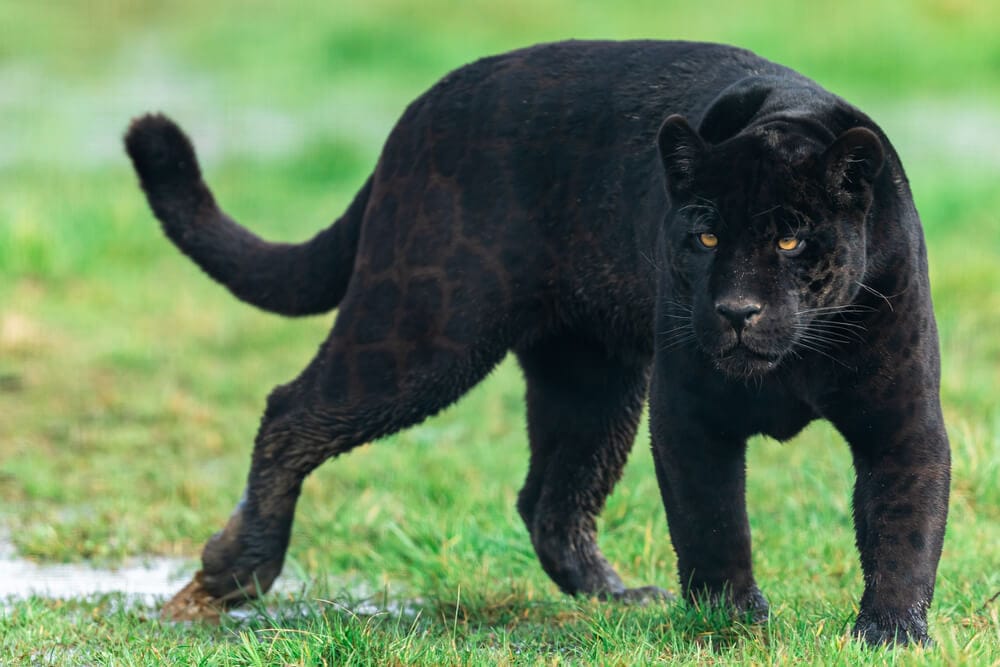
6. Black Panther
- Current ICUN Status: Rarer In Leopards, Roughly Endangered
- Typical Location(s): All Over The World
- Diet: Whatever Their Main Species Eats
Like White Panthers, a Black Panther is only black due to a random melanism change. They have dominant alleles or variant forms of a given gene. This often affects pigmentation, resulting in a color change. In humans, high melanin produces black people. The same occurs in Black Panthers, as their melanin goes to a higher number and that results in their color change to black. This is also recessive, which means they will likely pass it on to offspring, especially if they are male.
An interesting note about Black Panthers is that depending on the continent you live on, you’ll know what type of panther species you’re most likely to see. For the Americas, you’ll see black versions of jaguars. Meanwhile, in Africa & Asia, they will be leopards. Both have spots on them as well, but they are hidden by excess melanin. Black Panthers are feared by humans and animals alike and tend to be better hunters, especially when hunting at night and in jungle environments.
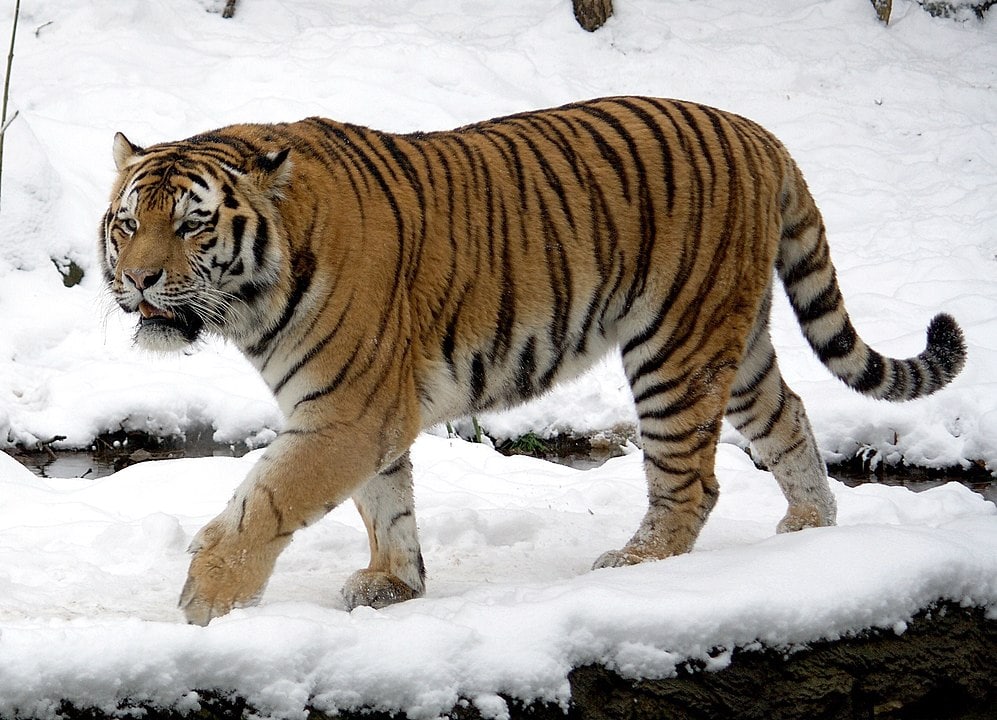
5. Siberian Tiger (Panthera tigris tigris)
- Current ICUN Status: Endangered
- Typical Location(s): Russia, China, North Korea
- Diet: Boars, Bears, Deer, Rabbits, Large Ungulates, Wolves, Leopards, etc.
Siberian Tigers were once the biggest predatory cats on the planet, at least as far as total size goes. However, the Ligers came along and overtook them for the top spot. These versions of the Tiger are still the largest pure tiger species on the planet, however. They are actually related to the Bengal Tiger, but the two are separated mostly by how big they are. Bengals often run smaller so Siberians are easy to separate from Bengals as a result.
Siberians have sadly dealt with similar issues other predatory cats have in that they have dealt with climate change, deforestation, and much more to result in a loss of habitat. They have also been a victim of poaching for several hundred years too. Habitat issues have been a problem for many animals, but the Siberian Tiger has had to share its habitat with leopards, bears, and more. This has resulted in Siberians being killed or killed both for survival and food.
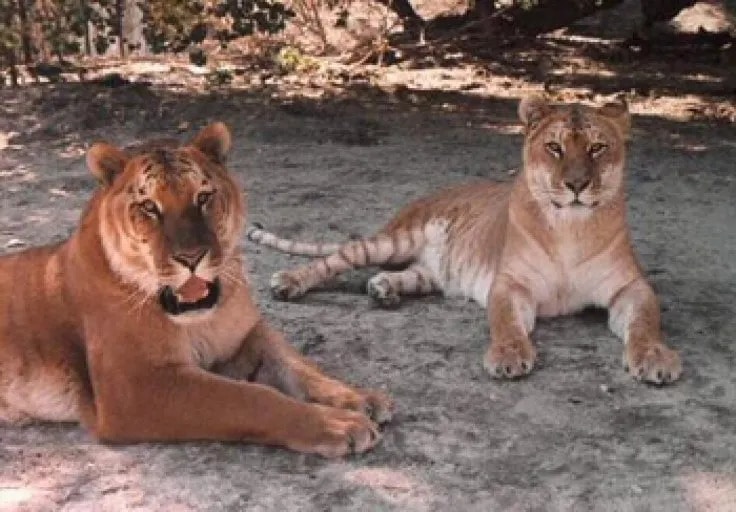
4. Li-Tigon/Ti-Tigon (Lion/Tigoness & Tiger/Tigoness Cross-Species)
- Current ICUN Status: Nonexistent
- Typical Location(s): Zoos, Captivity
- Diet: Whatever They Are Fed
Ligers are not the only hybrid that has been mated with normal lions and tigers. Tigons have also done so. Of course, like Ligers, the male Tigon cannot breed due to being sterile. However, females can breed and that has resulted in various places breeding them when possible. Li-Tigons are rarer than that of Ti-Tigons, and both are very different in appearance. This is quite obvious due to different fathers but the distinctions are quite interesting.
Li-Tigons have cubs that all seem to reach impressive size like their ligress mother. Due to the Lion DNA added in, they get to nearly the same size as Ligers. Thus far, we do not know if they can breed. Ti-Tigons are beautiful and tend to be called “golden tigers” due to their fur coming out in such a color. They also have less contrast in their tiger markings and males do not grow a mane, whereas they still do in Li-Tigons. Both are rare finds with Ti-Tigons having a low survival rate thus far.
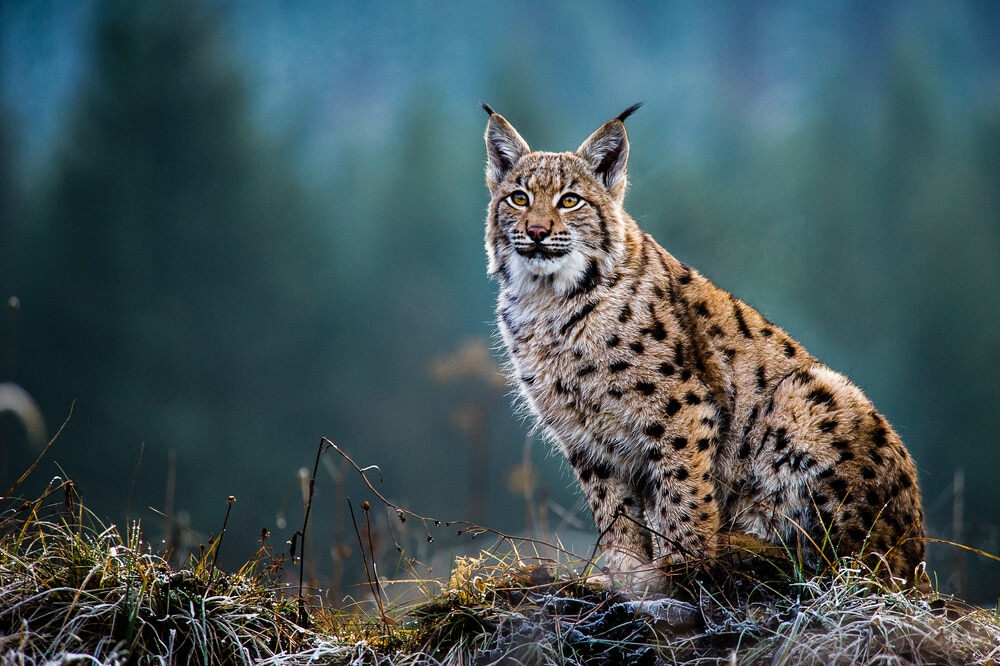
3. Eurasian Lynx (Lynx lynx)
- Current ICUN Status: Least Concern
- Typical Location(s): All Across Europe, Central Asia, Siberia, Tibetan Plateau, & The Himalayas
- Diet: Rabbits, Squirrels, Rodents, Red Foxes, Wild Boar, Moose, Deer, etc.
Eurasian Lynxes are considered historically significant predatory cats due to Egyptians believing them to be Gods. The people worshipped cats like the Lynx and that resulted in a lot of love for this particular species. Despite its name, the Eurasian Lynx is not only found in Europe and Asia. They were quite frequent in higher sectors of Africa, which is likely why the Egyptians ran into them so often, along with their Iberian cousin.
They happen to be the largest range of all predatory cats on the planet, resulting in the entire sector of Europe and Asia seeing them at one point in time. Eurasian Lynxes are the largest of the lynx family and are strict carnivores, usually going for smaller mammals. They are secretive, territorial cats that are usually found in forest or jungle-like regions. They often act like domestic cats, but don’t think this makes them lovable pets. They’re incredibly dangerous and capable of biting your arm off.
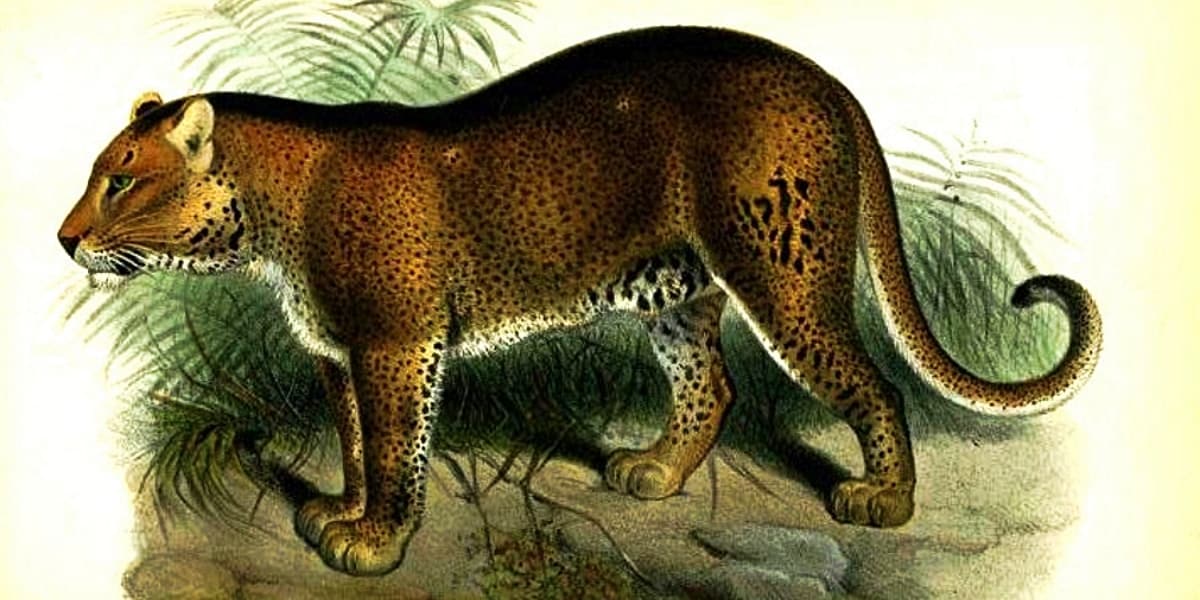
2. Congolese Spotted Lion (Lijagulep-Or Lion/Jagulep Cross-Species)
- Current ICUN Status: Nonexistent
- Typical Location(s): Zoos, Captivity
- Diet: Whatever They Are Fed
Normally, one would assume that the combo name of Lijagulep would have been given to these predatory cats. However, breeding Lions with Jaguleps has been a common practice. In fact, it was a big deal for showmen as they could show off an “exotic animal” that you could not see anywhere else. To be fair, hybrid predatory cats were always rare but never truly exotic. These showmen gave one the name of the “Congolese Spotted Lion” and it stuck to the hybrid species.
Basically, the showmen claimed it was a Lion from the Congo that was spotted like a leopard. None of the appearance content was fake but the stories used with them were never real. The public back in the early 1900s did not really care about hybrids, but when “exotic” was used, it caught everyone’s attention. This is the reason for the name being given and why “exotic” animals, which were often just hybrids, were even purposely bred at all.
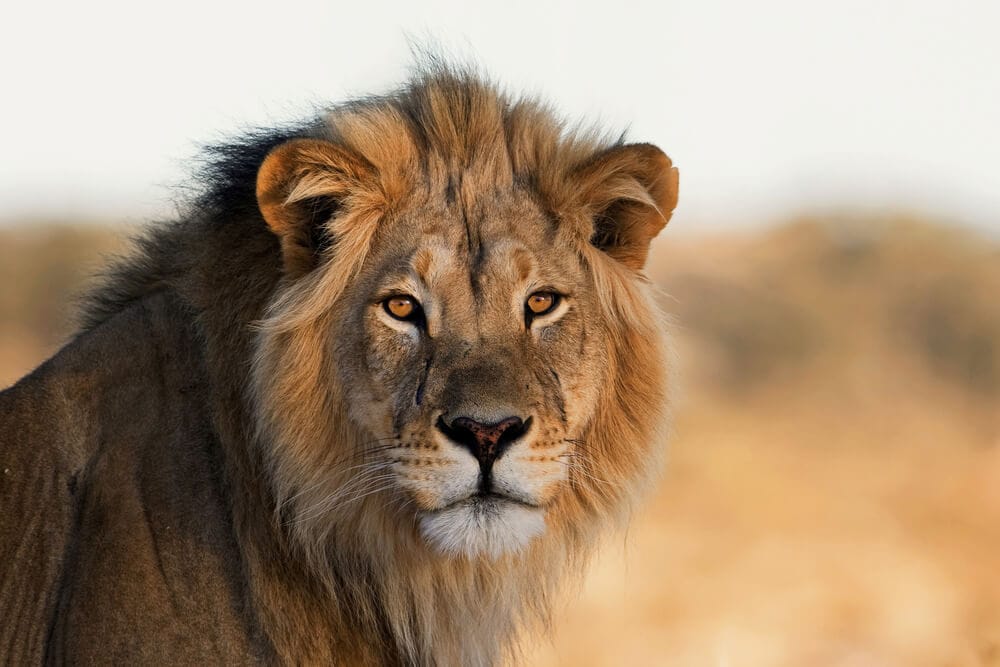
1. African Lion (Panthera leo)
- Current ICUN Status: Vulnerable
- Typical Location(s): All Over Africa, Lower Parts of Asia
- Diet: Gazelle, Zebra, Buffalo, Giraffe, Deer, Wildebeest, Warthog, Livestock
Lions are notable as likely most well-known and beloved of all the predatory cats on the planet. Often referred to as the “King of the Jungle,” lions are incredible creatures. The African Lion is the biggest of all known lion types that exist today, with males being the largest. They are also notable for their impressive mane, which is often used to help court lionesses. They are also very territorial of their pride and males tend to step up against the perceived alpha to challenge him on the regular.
Most of the time, male lions are quite lazy and sit out in the sun resting most days. They will attack and hunt when they have to, but if they are in a pack with lionesses, they basically let the ladies take care of the hunting. In packs, Lionesses tend to hunt a lot more than the males, even if pregnant. Mother lions often have to keep cubs away from the father for a few weeks after birth. Males are rough with their young and have even been known to eat them if allowed around them too early.
Sources: [National Geographic, Big Cat Rescue, Animal Planet, Science Daily, TheDodo.com, MNN.com, LA Zoo, Institute of Zoology, International Union for the Conservation of Nature]

